

EDUCATION PACK
WRITTEN BY ANNA RICHARDSON & MILLIE MANNING
He pou atua, he pou whenua, he pou tangata.
Ko Waitematā te moana
Ko Waikōkota te whenua.
Ko Te Pou Whakamaharatanga mō Māui Tikitiki a Tāranga te tohu o te kaha, o te kōrero, o te whakapapa o tēnei wāhi, o tēnei whare.
Nau mai e te tī, e te tā ki te whare kōrero, ki te whare whakaari o ASB ki te tahatika o te moana.
Mauri tau, mauri ora!
Pouwhakamaumāharatanga mō Māui-Tikitiki-a-Tāranga
The Memorial Post of Māui the Topknot of Tāranga
Robert Jahnke ONZM (Ngāi Taharoa, Te Whānau a Iritekura, Te Whānau a Rākairo o Ngāti Porou) 2016
Laminated tōtara and Corten steel
Proudly commissioned by Auckland Theatre Company for ASB Waterfront Theatre


The symbols of support, of strength and of guardianship stand fast and proud.
The waters of Waitematā ebb and flow against the shores here at Waikōkota, the land upon which we stand.
The pou of remembrance to Māui Tikitiki a Tāranga stands tall as a beacon of courage, of stories passed down and of the history that connects us all to this place and to this space.
We welcome you all from near and far to this house of stories, to the ASB Waterfront Theatre.
Mauri tau, mauri ora!

4 – 23 NOVEMBER 2025 |

NGĀ KAIWHAKAARI | CAST
Tiri — Miriama McDowell
Tilly — Nī Dekkers-Reihana
NGĀ RINGATOI | CREATIVE
He Kōpara — Haare Wiliams
Playwright — Witi Ihimaera
Director — Katie Wolfe
Kaihāpai Reo Māori & Translation —
Maioha Allen
Mātanga Whākaari & Script Editor —
Katie Wolfe
Set Design — John Verryt
Lighting Design — Jane Hakaraia
Costume Design — Te Ura Taripo-Hoskins
Composer & Sound Design —
Kingsley Spargo
Vision Design — Owen McCarthy
Movement Director & The Engine Room
Assistant Director — Katrina George
NGĀ KAIWHAKAHAERE HANGA | PRODUCTION
Stage Manager — Catherine Grealish
Staging Coordinator — Molloy
Technical Coordinator — Tim Jansen
Technical Operator — Bekky Boyce
Sound Coordinator — Sam Clavis
Audio Mix Engineer — Paige Pomana
Set Construction — Grant Reynolds
Make–up Design — Te Atawhai Curtis
Kairaranga — Jacquelyn Pako
Moko Artist: Moko Kauae — Fern Ngatai
Teaching Artists —
Millie Manning & Ella Rerekura
Education Pack Writer —
Anna Richardson
Publicist — Huia Ngapo
Community Liaison — Mark Thomson

Tiri: Te Araroa Woman Far Walking by Witi Ihimaera, directed by Katie Wolfe, is the sixth production in Auckland Theatre Company’s 2025 season. It began previews on Tuesday 4 November and opened on Thursday 6 November 2025.
Woman Far Walking by Witi Ihimaera was originally commissioned by the New Zealand International Festival of the Arts, 2000. The play was first directed by Catherine Downes MNZM, featuring Rachel House ONZM as Tiri and Rima Te Wiata MZNM as Tilly, and premiered in Soundings Theatre, Wellington, on Friday 17 March 2000. The production toured to Auckland, Gisborne, Hastings, Whakatāne and Hamilton.
The play was subsequently presented by Taki Rua Productions in July 2001, directed by Christian Penny, featuring Rachel House ONZM as Tiri and Nicola Kāwana as Tilly. The production toured to Taranaki, Wellington and Auckland.
In 2002, Taki Rua Productions toured Woman Far Walking again, directed by Nancy Brunning, featuring Kahu Hotere as Tiri and Riria Hotere as Tilly. The production toured to Christchurch, Dunedin, Hamilton, Palmerston North, Nelson and Manchester in the UK. This production is 1 hour and 30 minutes long, without an interval. It includes smoke and descriptions of violence. Please switch off all mobile phones and noise-emitting devices.

About This Pack
Auckland Theatre Company Education Packs supports your exploration of this production of Tiri Te Araroa Woman Far Walking by Witi Ihimaera. Whether you are a kaiako preparing lessons, an ākonga studying the play, or simply curious about this landmark work, this resource offers insight into this production.
The pack is divided into three sections:
About the Play
Making the Play
Activities
Includes a welcome from Auckland Theatre Company, key information about the cast and creatives, essays providing context and background, and a synopsis of the production.
Takes you behind the scenes and shares artefacts from the rehearsal room, design concepts, and notes from the creative team, offering a window into the making process.
Provides NCEA-linked classroom and independent exercises to help you unpack and explore Tiri Te Araroa Woman Far Walking. Activities support Achievement Standards across Levels 1, 2 and 3.
Each section builds on the previous one, but individual components can also be used as standalone resources. The activities are designed to complement the contextual essays and production insights, making the pack suitable for both classroom and independent learning.
About The Play
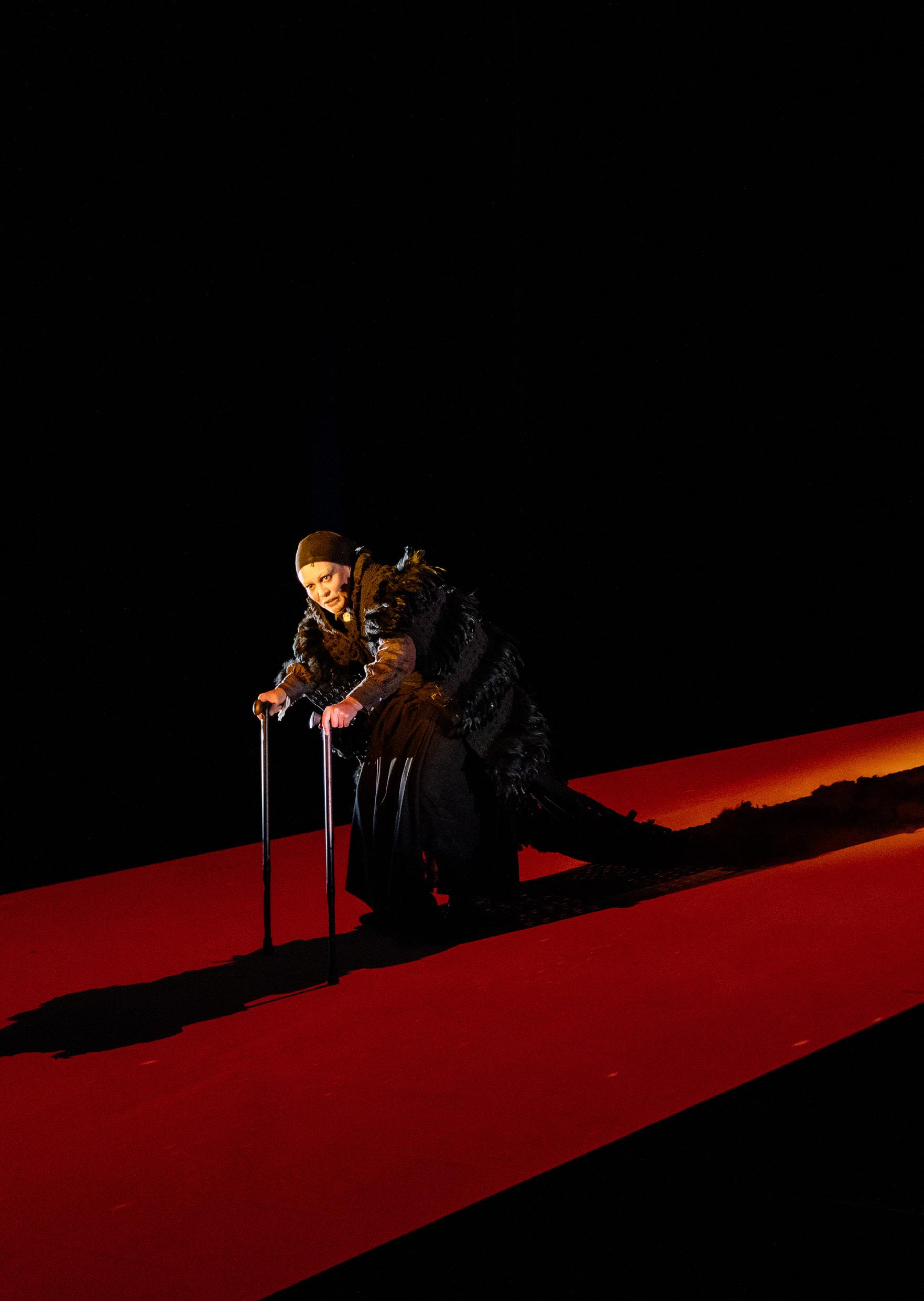
Introduction to the cast and creatives, essays providing essential context and background information, and a synopsis of the production.

Haere Mai
On 6 February 1840, a treaty was signed in Waitangi. Tiriti-o-Waitangi Mahana was born the same day. Now, after 185 long years of living, Tiri has something to say and we better listen up.
I acknowledge the productions of Woman Far Walking that have come before, starting with the Aotearoa New Zealand Festival of the Arts and Taki Rua Productions. Ngā mihi nui to the directors, the producers and, particularly, the actors who inhabited Tiri and Tilly to create some of our most vivid national theatre memories.
This new bilingual version, Tiri: Te Araroa Woman Far Walking, is Katie Wolfe’s vision and I salute her for her leadership. Katie is a fearless artist, forging a new path, and I feel like we are all just rushing to keep up. It is a truly exciting way to work.
This group of artists are working in a new way to create a fresh version of a classic play with a powerful whakapapa – and that requires entering a place of vulnerability. It is vanguard work and I mihi to each and every one of them for their boldness and courage.
As we welcome actors Miriama McDowell and Nī Dekkers-Reihana to the stage, please appreciate the long journey each, and those who stand behind them, has taken to this moment. It is no mean feat to overcome language dispossession and cultural suppression to stand on te atamira and tell 185 years of painful history in the reo rangatira.
Alongside us throughout the making of this work has been Tā Haare Williams, a man of extraordinary knowledge, an orator and storyteller. Haare’s presence has enabled us all to stand taller.
Witi Ihimaera DCNZM has been the guide, the mentor, the koro and the heart of this hīkoi. It is a privilege to revisit this beloved script and bring it to the big stage for a new era.
E te rangatira, te whakaute nui.
We extend our gratitude to Stout Trust for the gift towards this production’s development, and Creative New Zealand and Auckland Council for their steadfast commitment to our Company.
Jonathan Bielski Artistic Director & CEO

Note from the Playwright Witi Ihimaera
E ngā mana, e ngā reo, e ngā karangataha maha o te wā, tēnā koutou.
Tiri, in Woman Far Walking, is 185 years old this year. Her real name is Tiriti-o-Waitangi Mahana and she was born on 6 February 1840. She thought she was named after an Aunty, not a piece of paper! But what a piece of paper, nē rā? The founding document between Māori and Pākehā, no less.
This year the kuia rongonui returns through time to us to have her birthday in Tāmaki Makaurau at Auckland Theatre Company. She thanks the pōwhiri from the Board of Auckland Theatre Company and Artistic Director and CEO Jonathan Bielski.
Tiri has gone through a makeover for 2025. Enthralling wānanga by far-seeing director Katie Wolfe have ensured the Ringatū mātauranga (Ringatū knowledge) from rangatira
Sir Haare Williams and exceptional te reo from Maioha Allen are now within the kupu of Tiri’s voice.
You will be mesmerised as Tiri and her younger self, Tilly, chant, sing, laugh and cry our story in the two languages of our country. John Verryt, Jane Hakaraia, Te Ura Taripo-Hoskins, Kingsley Spargo, Owen McCarthy and Katrina George have brought epic scale to the kōrero. Ngā mihi aroha nui ki a koutou.
The kuia can’t wait to meet her iwi, Māori, tangata Tiriti, koroua, kuia, rangatahi katoa to give you a hug and to remind us all that the good things, the right things in life, are worth fighting for.
Tiri is the Treaty and the Treaty is her. Ko Tiri te Tiriti, ā, ko te Tiriti ko ia. Ngā kaitōrangapū ka rere ko te kupu a Tiri ka mau tonu.
Tēnā tātou katoa.
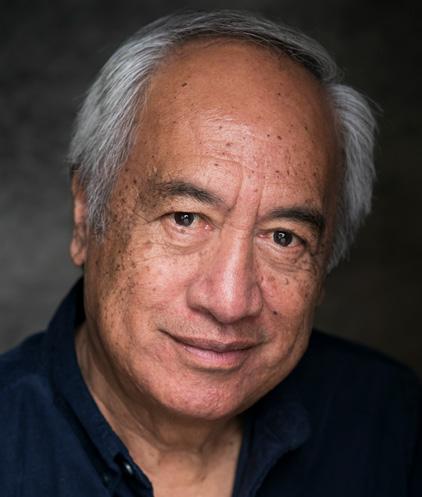
Playwright Witi Ihimaera
Te Whānau a Kai, Te Aitanga-a-Māhaki, Ngāti Ira, Ngāti Porou
Witi Ihimaera DCNZM QSM is the writer of three plays: Two Taniwha (1976), Woman Far Walking (2000) and All Our Sons (2015). His work has also been the basis of Albert Belz Whero’s New Net (2009) and Nancy Brunning’s Witi’s Wāhine (2019).
His major literary career, however, lies in Māori, New Zealand and Indigenous fiction, non-fiction and film. His first book was Pounamu, Pounamu (1972) and was followed by Tangi (1973), the first novel by a Māori writer. Over a 50-year career, highlights include The Matriarch (1986), The Whale Rider (1987), Bulibasha (1994), Nights in the Gardens of Spain (1995), The Dream Swimmer (1997), The Uncle’s Story (2000), The Parihaka Woman (2011), Māori Boy (2014), Sleeps Standing (2017), Native Son (2019) and Navigating the Stars (2020).
Ihimaera’s latest novel is Le Pacte des baleines, published in the French
language and launched in French Polynesia in September this year. In October, as Chairman of Te Kāhui o Ngā Kaituhi Māori, he helmed a ten-day wānanga in Tūranganui-aKiwa (Gisborne) for Māori writers. In November, he will tour France for a month to promote Le Pacte, which is a sequel to The Whale Rider.
Ihimaera has three new books forthcoming in 2026: Te Kaikaukau (The Swimmer), Ariā and the Monster Island and The Star Path (English edition of Le Pacte des baleines). He plans to write his first novel in te reo in 2027.
He pays homage to his cousin Sir Haare Williams, who has supported him throughout his career as a writer. He also conveys his aroha to Katie Wolfe, who directed Nights in the Gardens of Spain/Kawa (2010).
Witi Ihimaera travels the world but lives in Auckland.

He Kōpara Haare Williams
Te Aitanga-a-Māhaki, Rongowhakaata, Tūhoe
Tā Haare Williams was born in Te Karaka in the rural heart of Te Aitanga-a- Māhaki. At only a few months old, he became a living koha to his Tūhoe grandparents. He was raised in a whare raupo between Ōhiwa and Ōpōtiki, not speaking English until schooling started at seven. His grandparents Rimaha and Wairemana gardened, fished and preserved food according to maramataka and Haare was immersed in the practices of this generation. They exposed him to best practices for coexisting with the natural world and a diversity of mātauranga.
His physical nourishment matched the spiritual substance he received through Te Kooti’s scripture-based waiata, such as The Songs of David and Solomon.
Ringatū writings were inspirational texts and grew his love of language, poetry and narrative. His visual language gives new significance to values from his upbringing, his spiritual beliefs and personal experiences.
“l will continue to seek advocacy for the aspirations and initiatives that build rangatiratanga for rangatahi to be the best they can be. What we measure, we can manage and move beyond despair and drive towards more positive futures.” Of his art, he says, “I paint, I write, I narrate and I intone the living spirit in the spoken word.”
Williams KNZM JP PhD BA DipEd TTC
Haare


Director Katie Wolfe
Ngāti Mutunga, Ngāti Tama, Ngāti Toa Rangatira
Katie Wolfe is one of Aotearoa’s leading storytellers, acclaimed for weaving history and memory into powerful theatre and film. She is the creator of The Haka Party Incident, which premiered at Auckland Theatre Company in 2021 and then toured nationally. It won the Adam NZ Play Award and Best Production, Best Director and Best New Aotearoa Play at the Wellington Theatre Awards (2023).
Katie was the winner of the inaugural WIFT Mana Wāhine Award. Her other documentaries are He Māngai Wāhine and, for the Artefact series, Te Hokinga Mai and Road to War. Most recently, Katie was one of the directors of the acclaimed film Waru and Taranaki Cathedral’s Lament and Hope exhibition. Her films Redemption, This Is Her and Kawa (an adaptation of Witi Ihimaera’s Nights in the Gardens of Spain) have garnered many awards internationally. Katie directed The Mooncake and the Kūmara for the 2015 Auckland Arts Festival. Notable
other New Zealand works are Rendered for Auckland Theatre Company, Anahera for Circa Theatre, Luncheon for Basement Theatre and The Women for Silo Theatre.
The documentary film version of The Haka Party Incident premiered in 2023 and has played at film festivals in North America, Europe and Australia.

Note from the Director
When Jonathan Bielski asked me to direct Woman Far Walking, I knew that the time was right to bring our national languages together into a bilingual mainstage work. I am very grateful that the Auckland Theatre Company took a leap of faith, jumped on the waka and away we went.
When we created The Haka Party Incident a few years ago, we knew that we were introducing the audience to a risky, challenging work, but it was met with wild enthusiasm. Now, we push forward even further with a bilingual production. The arts-loving communities in Tāmaki Makaurau are a sophisticated, inclusionary society – a shining light amid some very murky times. I want to mihi to every audience member who turns up: your attendance is a form of allyship and shows your pride in our bicultural nation, you make Aotearoa more bright and positive. You walk alongside Tiri, knowing what is right and good and what is worth fighting for.
Tiri: Te Araroa Woman Far Walking is also an opportunity to bring together a team who I have worked with many times, a group of hoamahi who I
treasure. The incomparable John Verryt has designed all my work. He is my John Far Walking and this may be our last mainstage collaboration – but never say never. I love you my brother.
Mim and Nī, ngā pūngāwerewere e rua, two of Aotearoa’s finest stage artists, I feel such gratitude to walk this play with you. I have revelled in your kaha and your vulnerability to hold this work. To Haare Williams and Maioha Allen, ngā manu e rua, ngā mihi for your guidance and illumination of our reo and tikanga. And all the creative team, ngā mihi nunui, you have worked very hard and with such joy and lightness as we carried Tiri’s burden, just for this short time.
To my friend Witi Ihimaera, we first worked together in 2009 when I directed Kawa, the film version of Nights in the Gardens of Spain, and we now come together again to bring your beautiful, unprecedented, important and creatively sparkling work to life. I will always always treasure this collaboration. I have put all my blood, sweat and tears into making you shine like a comet in the night sky. You would expect nothing less.

Kaihāpai Reo Māori & Translation
Maioha Ki Te Ao Tūroa Allen
Ngāti Apakura, Kahungunu Whānui, Ngāti Hauaroa, Whakaue, Ngāti Porou
Born and raised in Waikato, Maioha Allen is an emerging Māori producer and artist. With a strong performance background, Maioha grew up immersed in the world of kapa haka through Te Whare Wānanga o Waikato, Te Ahikaaroa and Te Haona Kaha. This passion for the stage led to the honour of performing in Witi Ihimaera’s opera Flowing Water, an experience that deepened their commitment to Indigenous storytelling.
Maioha’s journey into producing was shaped through the Toi Māori Internship programme, under the mentorship of Tainui Tukiwaho and Amber Curreen, founders of Te Pou Theatre and Te Rēhia Theatre Company. This guidance provided a platform to develop practical skills and a deeper understanding of what it takes to create spaces for Māori theatre to thrive.
Since then, Maioha has contributed to a range of productions, including Hemo is Home, Kōpū, Mahuika, The Handlers, Te Tangi a Te Tūī and, most
recently, KARE TAO. Each of these experiences has added to their kete, building a unique perspective that blends lived experience, cultural grounding and creative vision.
At the heart of Maioha’s work is a passion for te reo Māori and a belief in the power of theatre to connect communities, celebrate whakapapa and inspire the next generation. Their vision is to continue expanding opportunities for rangatahi and Māori voices within the performing arts, ensuring that Māori language, customs and culture continue to thrive on stage.
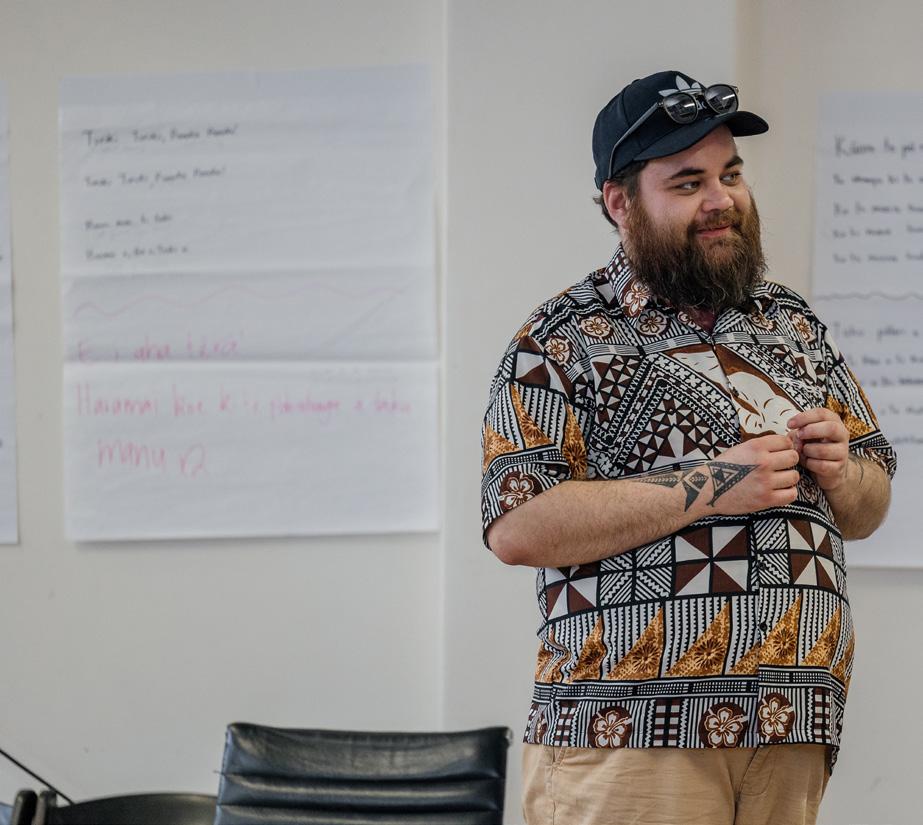
Note from Kaihāpai Reo Māori & Translator
Back in 2023, I was fortunate enough to spend a week with Katie and Miriama, developing Rangirua –Miriama’s first full te reo Māori solo theatre work. Through that process, a deep creative synergy was born between us. So, when Katie later rang to say she’d been invited to direct a piece by Witi Ihimaera, my answer came without hesitation – an enthusiastic āe!
Witi Ihimaera’s stories have always held a special place in my world. Growing up in a whānau of academics, teachers and avid readers, there was always a shelf in our home dedicated to Māori literary giants like Patricia Grace and Witi himself. Their voices shaped not only how we saw ourselves on the page and stage, but how we carried our stories into the world.
Tiri: Te Araroa Woman Far Walking is more than a play – it’s a reclamation. Tiri was 160 years old when she last graced the world, she is now 185. To re-imagine Witi’s powerful work with the addition of te reo Māori is to walk again in the footsteps of our ancestors, to breathe life into the language that holds our identity, and to celebrate the mana of those who have carried our stories through generations.
This process has been an act of aroha and rediscovery – for Katie, for Miriama, for Nī, for Witi and for myself. As you watch Tiri’s journey unfold, I invite you to listen beyond the words, to hear her heartbeat, and to walk with us – even for a moment – along this path of remembrance, resilience, return and reclamation.

Te Reo o Tiri

Kāore te pō nei i mōrikarika noa –
Traditional Chant by Te Kooti
E ako au ki te haka – Traditional haka
Ka Mate Ka Mate – Composed by Ngāti Toa Rangatira Chief, Te Rauparaha
Turuki Turuki, Paneke Paneke –
Traditional haka
Rimurimu – Traditional waiata
E pari rā – by Paraire Tomoana (Ngāti Kahungunu)
E te Hokowhitu a Tū – by Tuini Ngāwai (Te Whānau a Ruataupare)
Kei wareware i a tātou – by Charlton Te Wake-Matthews & Makere Ngaropo Hati
Te Waiata Whakamoemiti a Rāwiri rāua ko Horomona (Song of Praise of David and Solomon) – Traditional waiata of the Hāhi Ringatū, attributed to Te Kooti Arikirangi
Te Turuki and drawn from the Psalms of David and the Proverbs of Solomon. Used with respect and acknowledgment of the whakapono and tikanga of the Ringatū faith and its people. Tune composed by Hohepa Tamehana (Ngāti Haka–Patuheuheu).
Ka Panapana – Traditional Ngāti Porou haka
Introduction
On 6 February 1840, Te Tiriti o Waitangi (the Treaty of Waitangi) was signed at Waitangi, establishing a promise of partnership between tangata whenua and tangata tiriti.
In Tiri Te Araroa Woman Far Walking, the character Tiriti o Waitangi Mahana has lived for as long as the Treaty itself. She is telling her story—our story—across nearly two centuries of change.
First written by Witi Ihimaera in 2000, Woman Far Walking premiered at the New Zealand International Festival of the Arts in Wellington, starring Rachel House as Tiri and Rima Te Wiata as Tilly. The following year, Taki Rua Productions toured the play nationally, featuring Rachel House and Nicola Kawana. Since then, Ihimaera has revisited and revised the work, each version responding to Aotearoa’s evolving political, cultural, and linguistic landscape.
Over the past 25 years, the revitalisation of te reo Māori, the growth of kaupapa Māori education, and the continuing work of the Waitangi Tribunal (established under the Treaty of Waitangi Act 1975) have shaped national conversations about identity, equity, and history.
In 2024, director Katie Wolfe approached Auckland Theatre Company’s Artistic Director Jonathan Bielski with a vision to reawaken the play for contemporary audiences. The idea immediately resonated, and development began in early 2025. Before rehearsals commenced on 29 September, the creative team held three wānanga to explore how the play could speak to this moment in Aotearoa’s story. Wolfe worked closely with Ihimaera and Kaihāpai Reo Māori Maioha Allen to evolve the script into its current bilingual form.
This new production of Tiri Te Araroa Woman Far Walking draws from what Wolfe calls Ihimaera’s “impossible moments” — powerful images and emotional truths that test the limits of theatre. The result is a sweeping, visceral reimagining that fills the ASB Waterfront Theatre with light, language, and the enduring presence of Tiri — the matriarch who walks through postTreaty time, carrying both the grief and the beauty of our shared history.
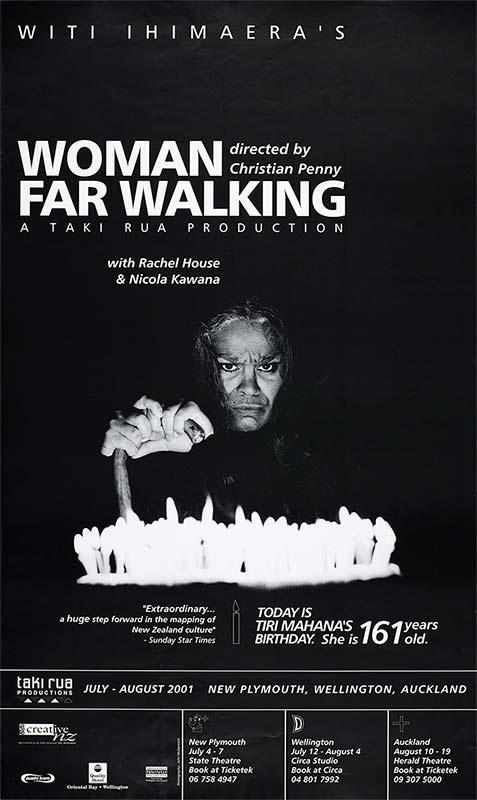
Poster of the 2001 production, directed by Christian Penny.
Synopsis
For as long as Māori and Pākehā have shared Aotearoa, Tiri has walked with us all.
Spanning 185 years of Aotearoa’s history, Tiri Te Araroa Woman Far Walking follows Tiriti o Waitangi Mahana—Tiri for short—as she walks from 1840 to the present day. Born on the same day the Treaty of Waitangi was signed, Tiri has lived through every era that has shaped the nation.
She is joined on stage by Tilly, a living echo of herself. The two performers—sometimes companions, sometimes challengers—speak directly to the audience, shifting between memory, history, and imagination. Together they reawaken moments from Aotearoa’s past: the arrival of Captain Cook, the signing of Te Tiriti o Waitangi, the New Zealand Wars, the rise of the Ringatū faith, the world wars, the 1918 influenza pandemic, the 1981 Springbok Tour protests, and the Waitangi commemorations that continue into the present day.
Structured in five parts, the play moves through ritual, battle, and rebirth. Haka, mōteatea, and karakia thread through the performance, with te reo Māori and English in constant dialogue. As Tiri endures while generations around her die, she wrestles with grief, resilience, and the responsibility of remembering.
This 100-minute bilingual production blends Witi Ihimaera’s poetic storytelling with Maioha Allen’s language adaptation and Katie Wolfe’s visceral direction. The result asks how we will walk forward together, honouring the past while shaping the future.
TILLY
Can New Zealand resolve the past?
TIRI
What is our future together?
TILLY
Can we even talk about a future if the rangatahi are not at the table?

Historical Context
At the heart of Tiri Te Araroa Woman Far Walking lies Witi Ihimaera’s central metaphor — naming the protagonist Tiriti o Waitangi Mahana after Aotearoa New Zealand’s founding document.
Te Tiriti o Waitangi (The Treaty of Waitangi) was drafted by Lieutenant-Governor William Hobson and translated into te reo Māori by missionary Henry Williams and his son Edward on 4 February 1840.
It was debated by Māori rangatira at Waitangi and signed there on 6 February 1840 by Hobson, several British residents, and around 43–46 Māori chiefs, beginning with Hōne Heke. Over the following months, additional copies were taken around the motu for further signatures.
Before the signing, rapid growth in European settlement and trade led the British Crown to seek formal authority to govern. The
Treaty’s three articles expressed broad principles of partnership, protection, and participation — but the English and Māori versions differed in meaning. In particular, sovereignty in English was translated as kawanatanga (governance). Many Māori understood this to mean that the Governor would oversee Pākehā settlers while Māori would retain tino rangatiratanga (full authority) over their own lands, resources, and affairs.
Although Te Tiriti itself has never been amended, its interpretation has evolved through legislation and court decisions. Repeated breaches of its principles led to the establishment of the Waitangi Tribunal under the Treaty of Waitangi Act 1975, giving Māori a legal process to investigate historical and contemporary claims against the Crown.
Today, the Treaty remains central to national discussions about language, identity, environmental protection, and political partnership. The play reflects this living debate, touching on the resurgence of te reo Māori, the rise of kaupapa Māori education, and the continuing struggle for equity and recognition.
Throughout Tiri Te Araroa Woman Far Walking, Tiri herself embodies the Treaty’s long life — carrying its promises, breaches, and hopes across generations. Her moments of silence and resistance mirror the country’s own discomfort in facing difficult histories, while Tilly’s insistence on speaking symbolises the need for open dialogue and truth-telling. Together they enact the whakataukī “Ka mua, ka muri” — walking backwards into the future — reminding audiences that understanding and reconciliation begin when stories are shared.
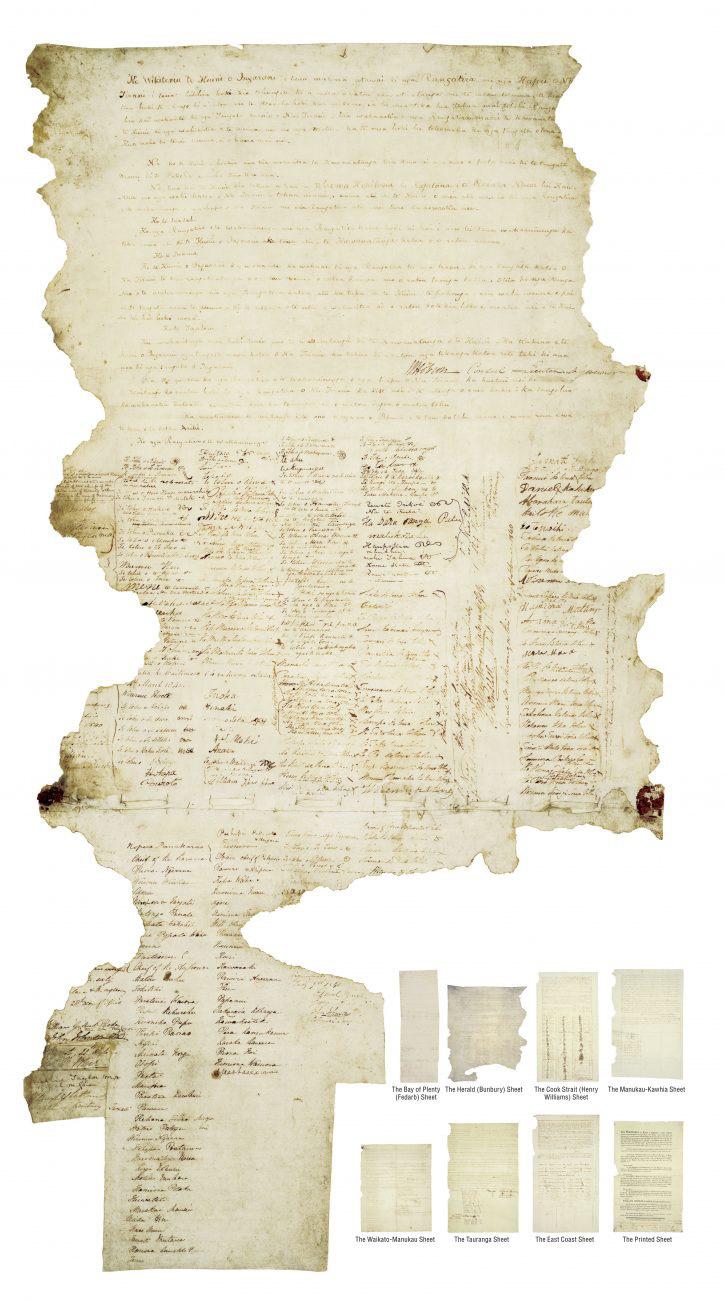
The Waitangi Sheet: one out of nine documents as part of the Treaty of Waitangi.
Timeline
YEAR EVENT
1840 Te Tiriti o Waitangi signed at Waitangi between the British Crown and Māori rangatira.
1868–1872
1914–1918
New Zealand Wars reach Te Tairāwhiti; Te Kooti leads the Ringatū faith and armed resistance.
World War I — the Battle of the Somme.
1918 Influenza Pandemic devastates Māori communities.
1940 Treaty Centennial — Tiri receives her moko kauae.
1975 Treaty of Waitangi Act establishes the Waitangi Tribunal to investigate Crown breaches of Te Tiriti.
1981 Springbok Tour protests.
2000 Woman Far Walking by Witi Ihimaera premieres at the New Zealand International Festival of the Arts in Wellington, directed by Cathy Downes and starring Rachel House.
2025 Tiri Te Araroa Woman Far Walking — Reimagining directed by Katie Wolfe premieres at the ASB Waterfront Theatre.

Making the Play
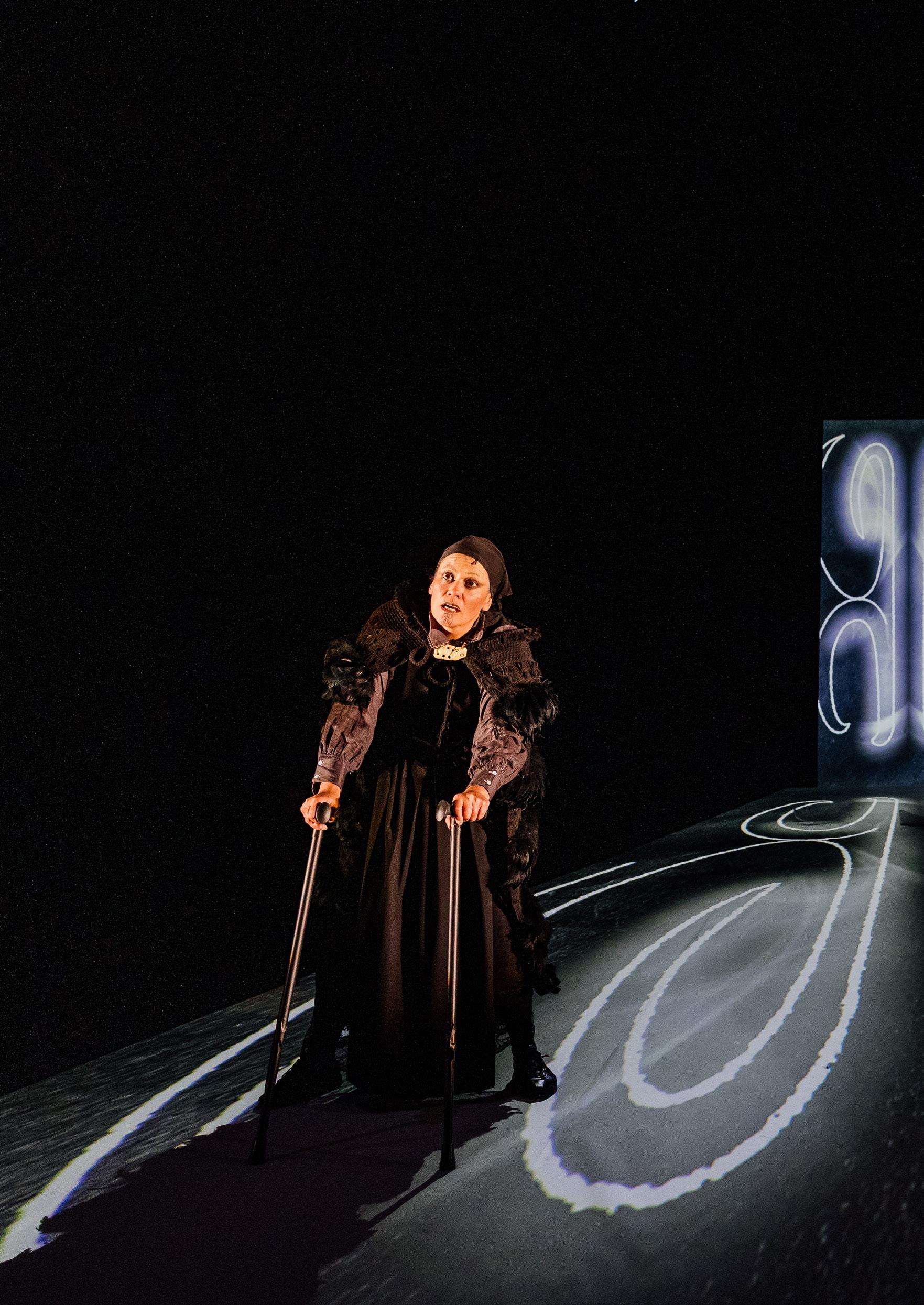
Come behind the scenes and see images from the rehearsal room, design concepts, and notes from the creative team, offering a window into the making process.
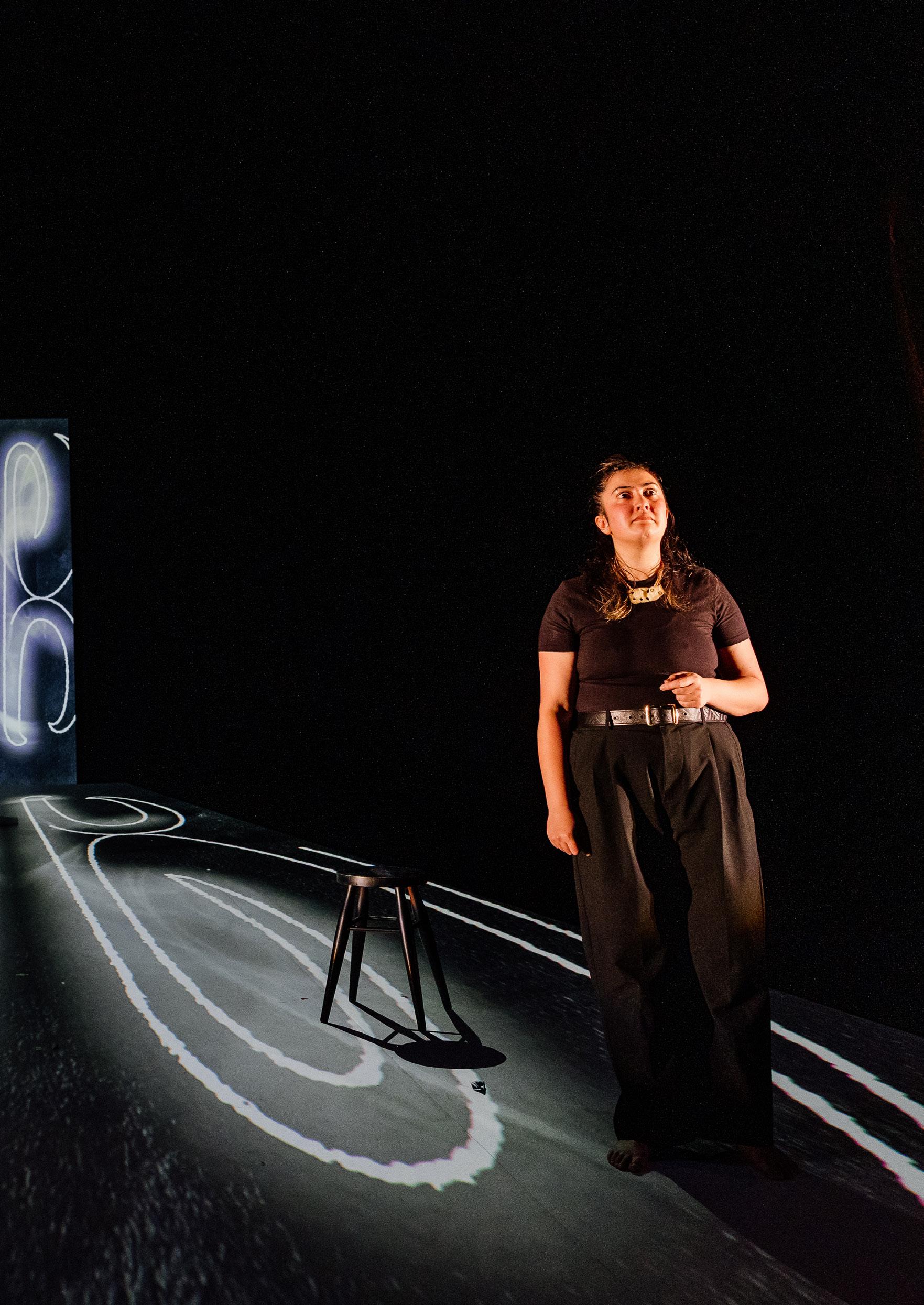
Director’s Vision
In this new rendition of Woman Far Walking, te reo Māori stands alongside English as an equal voice in meaning and mana. Director Katie Wolfe has chosen to use te reo Māori as extensively as possible, allowing the story to move fluidly between both languages. Bilingual storytelling invites both fluent speakers and learners into the same space. Her vision is for the production to belong to both reo speakers and reo learners — a bicultural audience.
Witi Ihimaera structured Woman Far Walking without traditional scenes. To guide the creative process, Wolfe divided the script into ten chapters. Each chapter marks a thematic and historical shift rather than a linear plot point. The structure allows Tiri’s memory to move fluidly through time, weaving history, poetry, and ritual into one continuous performance.
The play has evolved since Ihimaera’s original 2000 version — and even since Wolfe’s first draft. Her collaborative process invites contribution from all members of the creative team, encouraging change when it deepens authenticity. For example, during the first day of rehearsals, a key shift occurred in the New Zealand Wars sequence. In earlier versions, Tiri’s people pray through the Ringatū faith, asking to be delivered from “the slavery of Egypt.” Wolfe and the team replaced this with the haka Ka Panapana, written by Ngāti Porou and performed by wāhine, grounding the scene in iwi-specific cultural practice.
Similarly, Kaihāpai Reo Māori and translator Maioha Allen and mātauranga Māori advisor Merepaea Dunn worked closely with Wolfe to ensure language choices reflected both historical accuracy and emotional vitality. As Wolfe explains, “Maioha isn’t the reo police — they help us find kupu that are alive, full of humour, energy, and truth in the moment.”
Working alongside the design team, Wolfe established two dominant tonal states: heavy darkness and heavy brightness. The play moves abruptly between these extremes — with no soft transitions — to disorient the audience and mirror Tiri’s experience of trauma and resilience. Throughout, direct address is crucial: the actors speak forthrightly to the audience, breaking theatrical boundaries and invoking the immediacy of whakawhanaungatanga.
In rehearsal, Wolfe often refers to the matakore (“no-face”) state — the moment when Tiri, overwhelmed by memory, withdraws from her story. Sometimes she sends the audience away; other times she leaves them behind. The lighting design amplifies these shifts, reinforcing the existential cost of memory and resisting the romanticisation of war. These matakore moments sit at the centre of Wolfe’s vision: where silence, absence, and trauma become as powerful as voice, presence, and resistance.
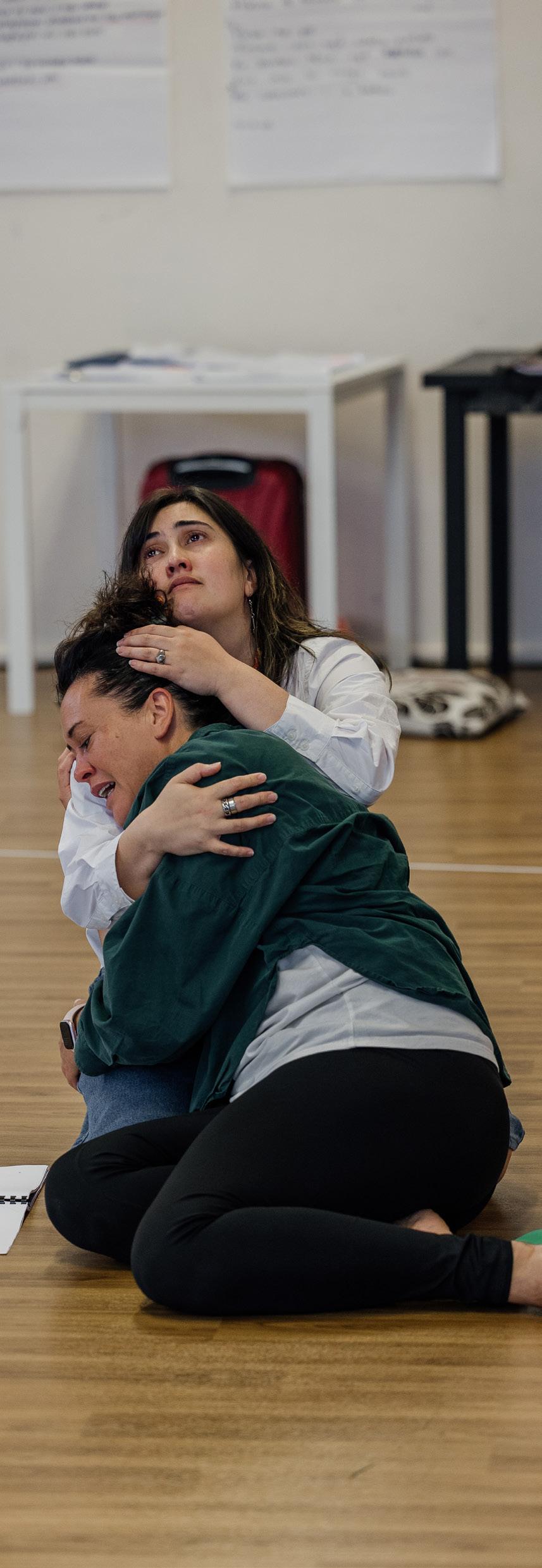
Witi Ihimaera
The Writer
We asked Witi some questions about the text he has written, and this production at the ASB Waterfront Theatre.
Students are often asked to write about the ihi and wehi of a performance and how it creates wana. For you, what are the most significant moments that reach out to the audience and touch them?
“In this production, Tiri speaks from the arero (tongue) and affirms her strength and mana. She also addresses the dawn. Hikurangi is the first place on the earth’s surface to see the sun each day. Those moments are among the most powerful times when she locates everybody, so they understand that she is speaking for the mountain. Another moment audiences will connect with is when she receives her moko kauae. Tiri is the embodiment of the Treaty, and when the moko is placed on her chin, the principles of Te Tiriti are made visible — tattooed into her very skin.”
For you, what moment in the play captures the wairua of the whole show?
“Tiri has lived a long time — 185 years. She’s lived through our country’s passions, joys, and tragedies. One of the major themes is that she has also been at war.
The moment that captures the wairua for me is during the Springbok Tour, when she speaks directly to the audience while seeing Kiri Te Kanawa singing in Molesworth Street through a shop window. The juxtaposition of a Commonwealth celebration in London in July 1981 with the Molesworth Street protests in Wellington is simply chilling.”
What is the significance for you of having your work in both te reo Māori and English?
“My gosh, who would’ve thought it? That a play in Aotearoa could be performed in both our languages. I only went to Takiura a year ago, and to now hear the words spoken on stage in te reo Māori is pretty awesome.”
There have been many iterations of this play on stage, including the Taki Rua production directed by Nancy Brunning. How is this one different in your eyes?
“Tiri has walked from the East Coast — from small audiences of whānau and iwi around the mōtu — all the way to the main stage of Auckland. She’s reached the pinnacle of her representational glory.”
What do you want rangatahi to know?
“As a playwright, and as a company, we’re asking the audience — especially rangatahi — ‘What do you want for the future? Can Aotearoa resolve the past? What is our future together? And can we even talk about that future if rangatahi are not at the table?’
Rangatahi need to be at the table of Aotearoa. If you were there, what would you ask of your country for your generation?”
Design
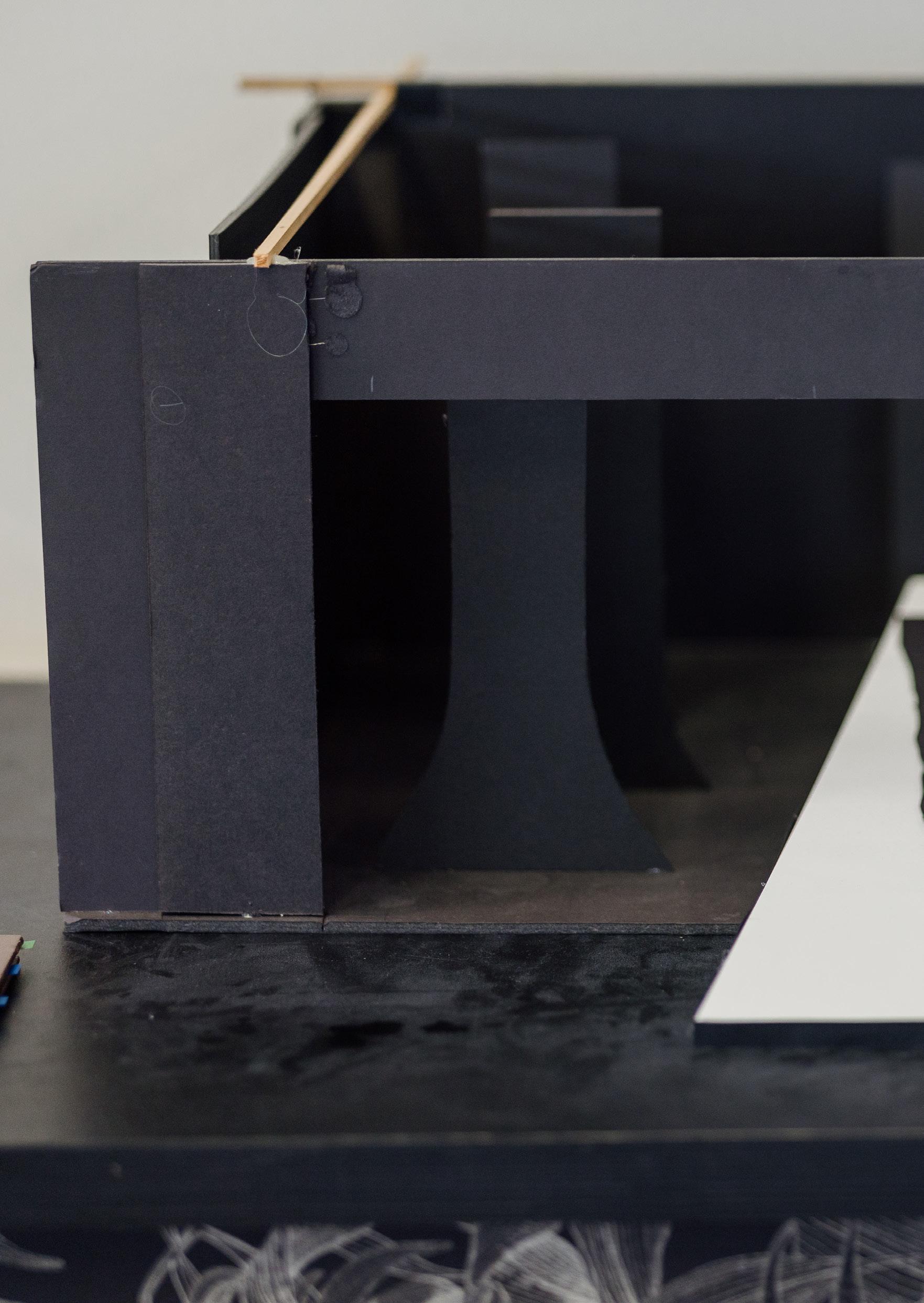
The design of Tiri Te Araroa Woman Far Walking brings Witi Ihimaera’s world to life through shifting light, sound, and form.
The design team — led by John Verryt (Set Design), Jane Hakaraia (Lighting Design), Te Ura Hoskins (Costume Design), Kingsley Spargo (Composer & Sound Design), and Owen McCarthy (Vision Design) — worked closely with director Katie Wolfe to create a world that feels both ancient and immediate.
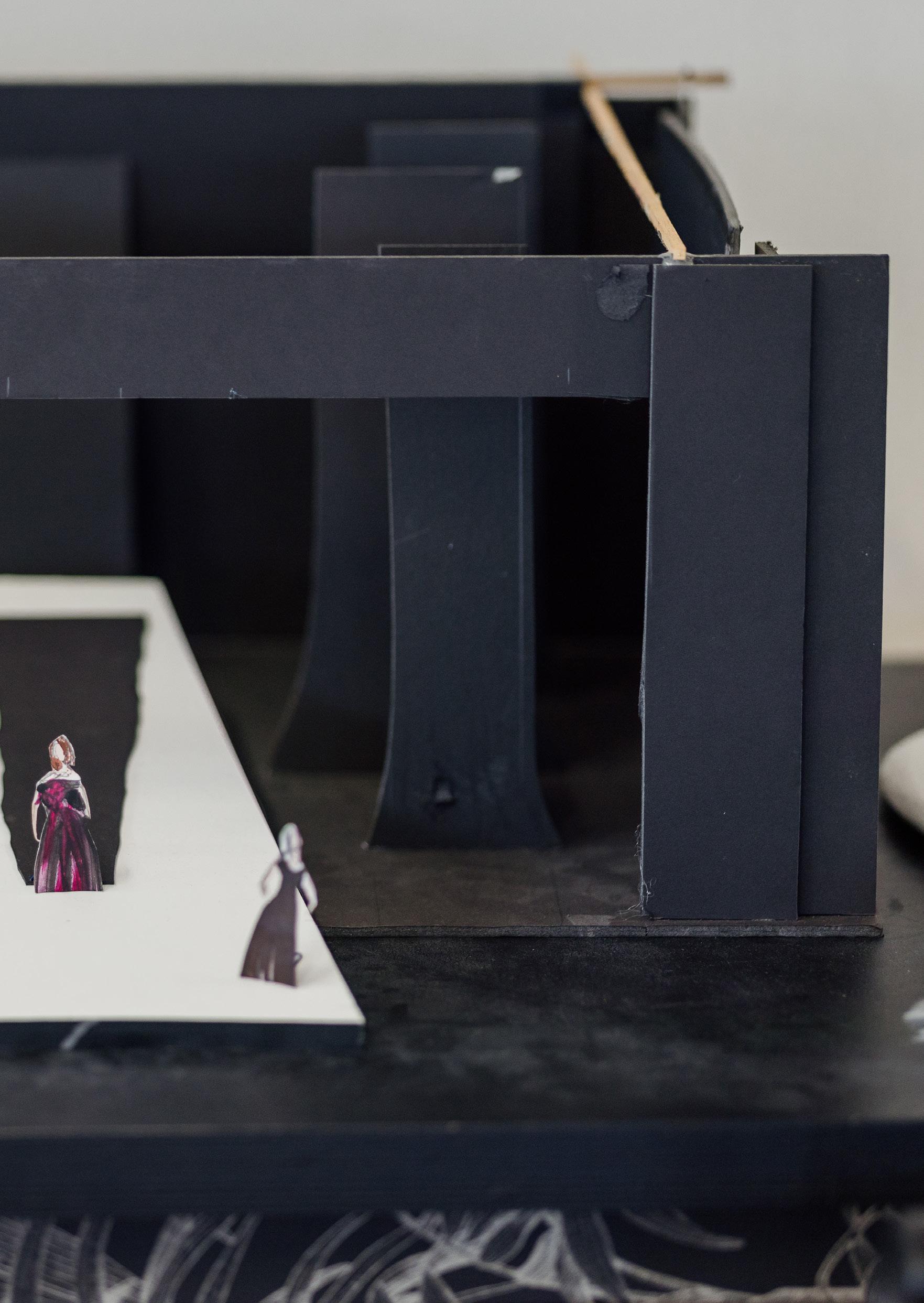
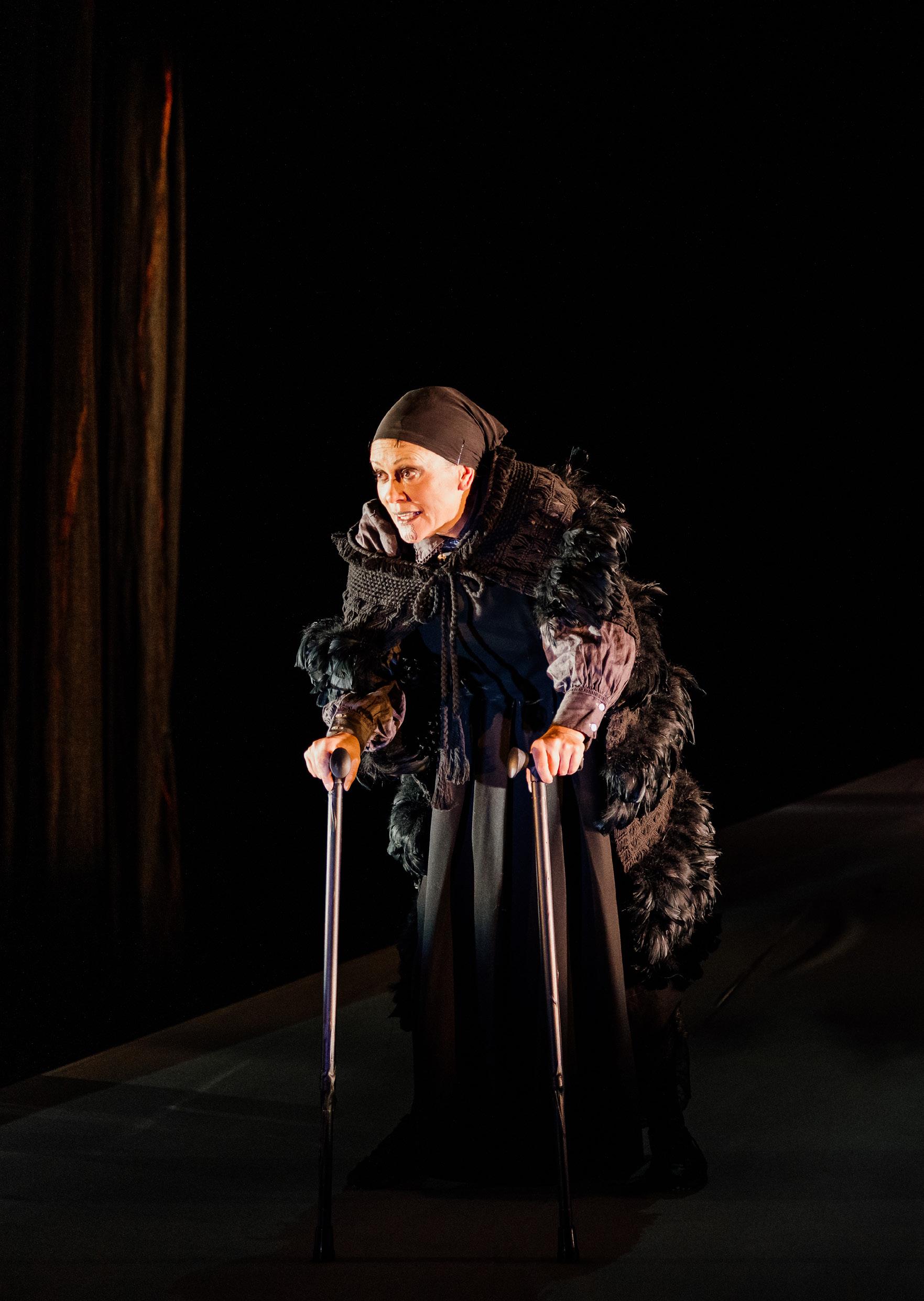
Set Design
Set design during John’s design presentation
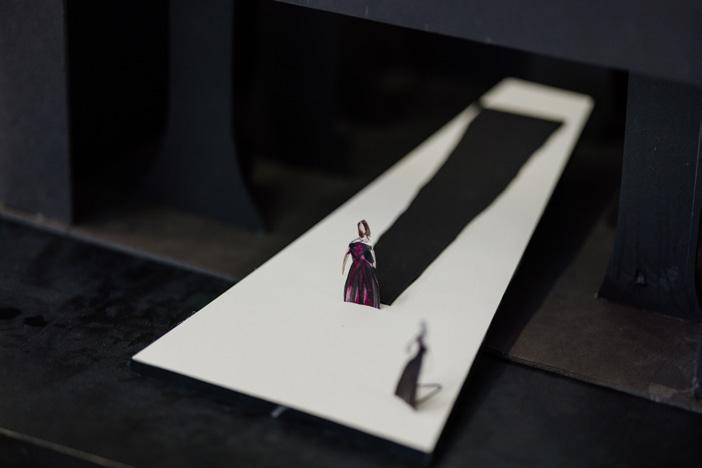
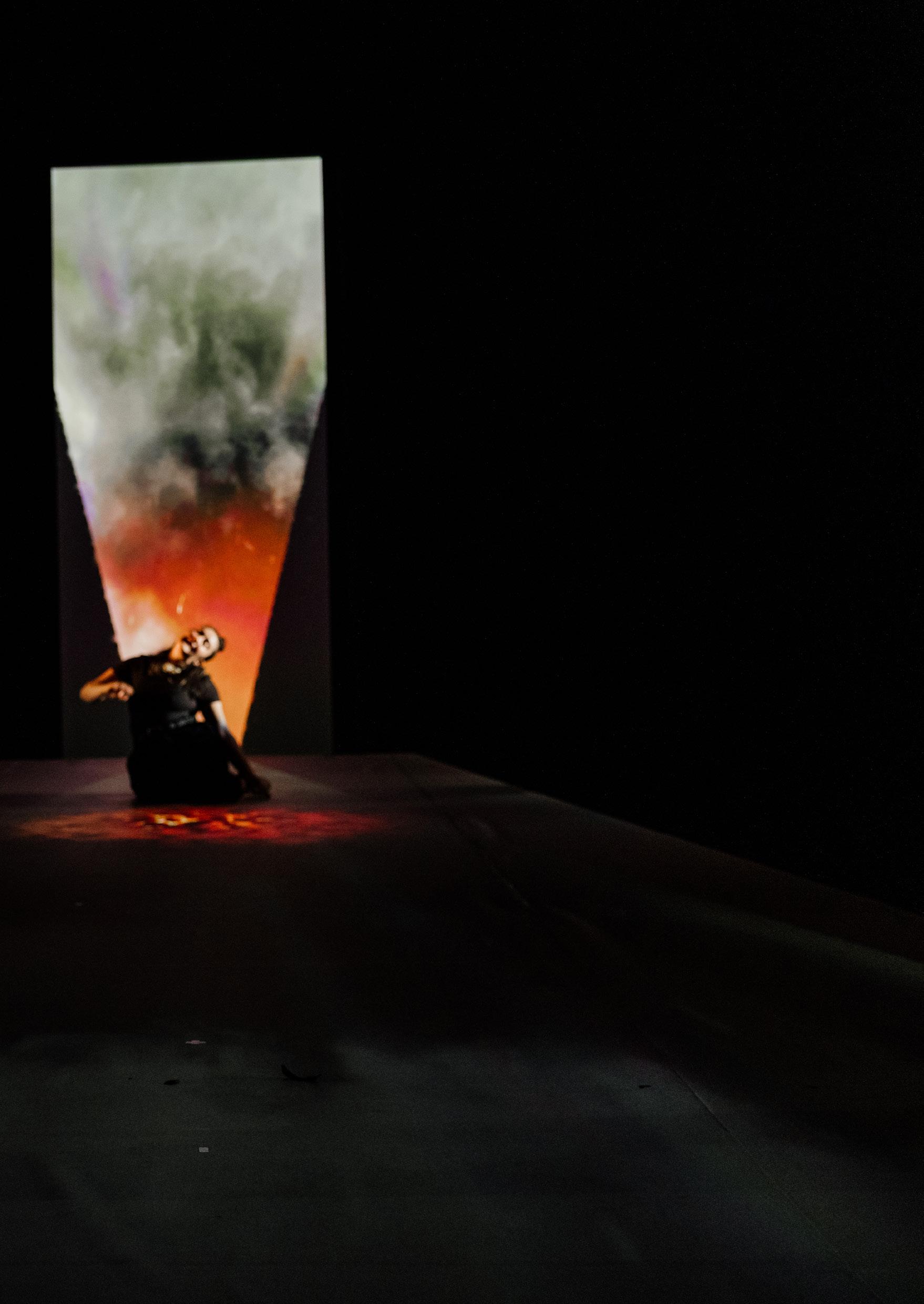
Set designer John Verryt has created a 12-metre-long, toki-shaped platform that extends from the stage into the audience. This design breaks the traditional fourth wall of the ASB Waterfront Theatre’s proscenium arch, allowing Tiri to move among the audience and speak directly to them.
The toki represents the tip of a taiaha — the arero (tongue). When Tiri stands upon it, language itself becomes a living presence on stage. Behind the platform, adjustable tabs open to reveal the sky of Tiri’s world, expanding the sense of distance and possibility.
Flanking pillars made of gorse stand like trees on either side of the toki, evoking both beauty and resistance. A hidden trap built into the platform allows actors to enter, exit, and clear small props — a ukulele and a stool — with precision and ease.

Costume design sketches by Te Ura Taripo-Hoskins.

Costume Design
For Tiri:
Costume designer Te Ura TaripoHoskins has created a look grounded in natural fibres and colonial silhouettes — a black T-shirt, skirt, and headscarf forming Tiri’s everyday attire.
Tiri also wears a striking kākahu huruhuru designed by Te Ura TaripoHoskins, with kairaranga Jacquelyn Pako. Made from cotton mop string and geese feathers, the garment combines whatu and māwhitiwhiti weaving techniques. Whatu diverts the whenu (warp threads) vertically to form negative space and contrast, while māwhitiwhiti crosses fibres to symbolise exchange, meeting, and agreement.
The finished kākahu extends approximately seven metres, weighs nearly 20 kilograms, and trails behind Tiri as she walks — its deliberate gaps and broken patterns representing the loss and endurance carried through her long life.
Tiri’s walking stick is still in development. One concept draws inspiration from Te Ura’s koro of Te Tai Tokerau, who would knot vines as they grew to form walking sticks; another option uses driftwood gathered from the moana.

For Tilly:
Nī Dekkers-Reihana’s base costume — black pants and a black top — remains constant throughout the performance. The simplicity of this design provides freedom of movement and practicality, allowing Nī to embody multiple characters without distraction. This streamlined approach still honours the pīwakawaka energy of Tilly — fluid, adaptable and evershifting — as they move between roles, genders, and generations, connecting to both Tiri and Tilly through gesture and presence rather than costume change.

Lighting Design
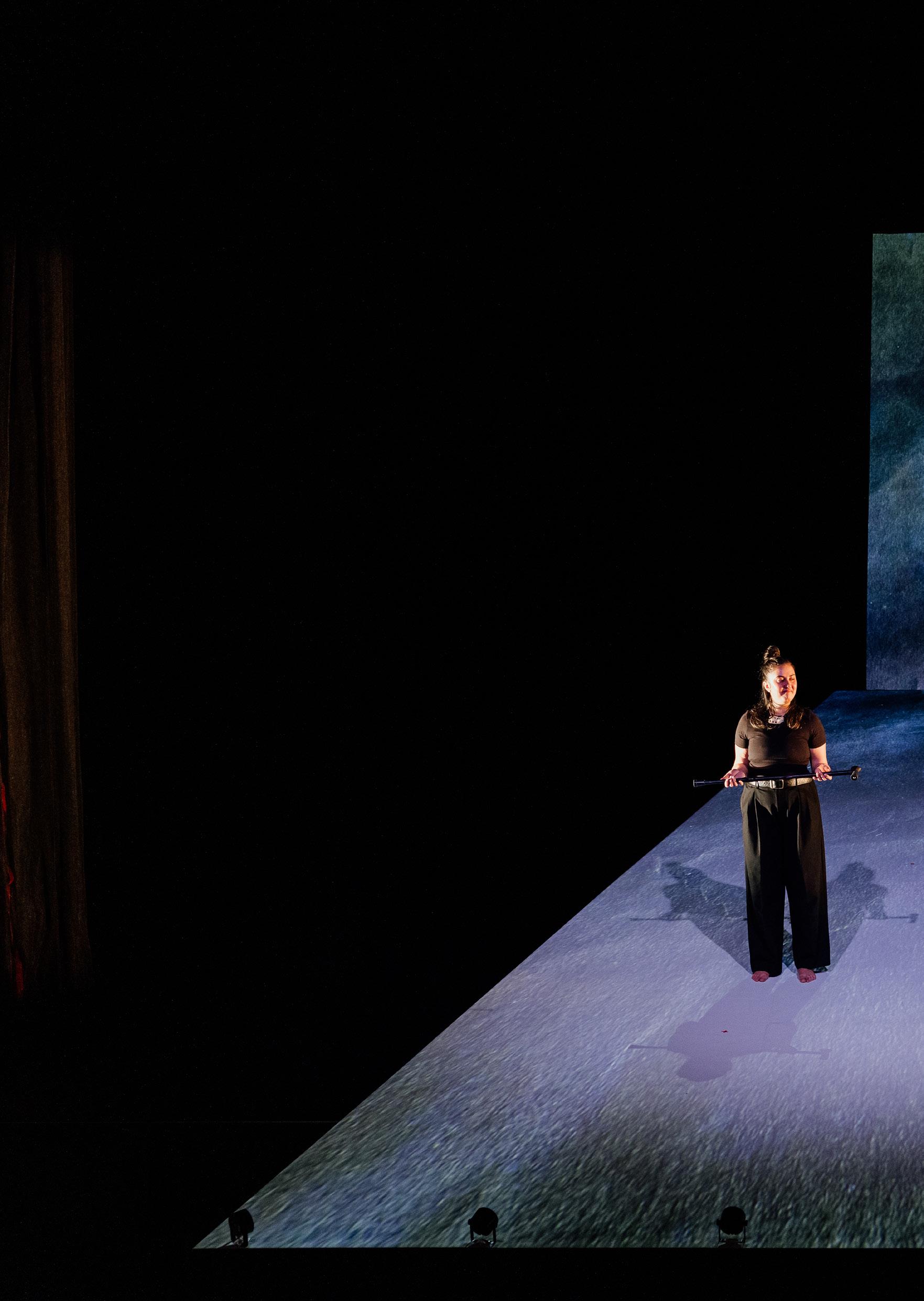
With a minimal set, lighting becomes central to shaping the world of Tiri Te Araroa Woman Far Walking. Designer Jane Hakaraia uses light and shadow to define emotion, movement, and memory within the space.
The textured gorse “trees” framing the stage offer rich opportunities for play. By sending light through their tangled surfaces, Hakaraia reveals both beauty and danger — echoing the resilience and sharpness of Tiri’s journey.
Two base states anchor the design. The first is dark, cool, and dynamic, supporting the play’s non-verbal sequences and moments of stillness.

Lighting states by Jane Hakaraia.

The second is a heavy, bright wash that bounces off white surfaces like the toki, creating stark contrast.
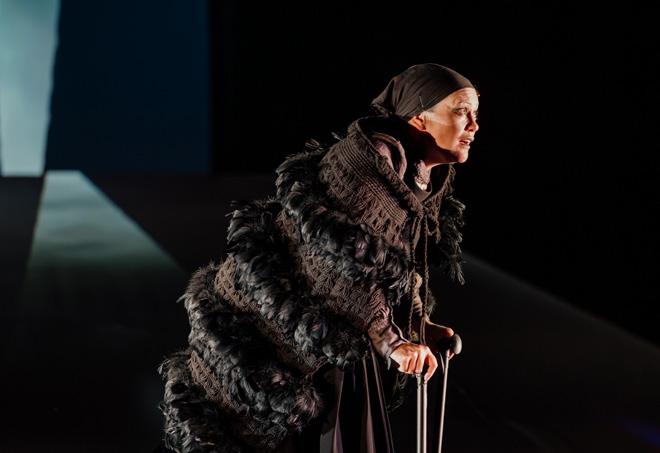
These lighting states collide rather than transition smoothly, amplifying tension at key moments, particularly when Tiri speaks directly to the audience.
Hakaraia also works with silhouette and fog to shape the play’s atmosphere. Early in development, she imagined the opening moment: lights snapping up on Tiri, her figure sharply outlined against rolling fog spilling down the toki. This image sets the tone — a powerful emergence that establishes both the scale of Tiri’s world and the shadows she walks through.
Sound Design
Sound designer and composer
Kingsley Spargo blends birdsong with taonga pūoro (traditional Māori instruments) to evoke the atmosphere of Tiri’s memories. His design transports the audience through time, grounding the story in the natural world and its ancestral voices.
Spargo worked directly in the rehearsal room with the actors — an uncommon privilege, he says — experimenting in real time to find the sounds that respond to their movement and emotion.
The soundscape features the hue puruhau (whose whakapapa connects to Papatūānuku), the pūtātara (linked to both Papatūānuku and Tangaroa, its string binding symbolising reconciliation between the brothers), the kōauau, and the kōhatu. Together, these instruments create a living sonic environment that breathes with Tiri’s world — earthy, spiritual, and deeply rooted in Te Ao Māori.

Kingsley Spargo demonstrating taonga pūoro in rehearsal.

AV Design

Owen McCarthy, Vision Designer, has created projected imagery that weaves through Tiri Te Araroa Woman Far Walking — a shifting landscape of still and moving images rich in tone and colour.
Each visual sequence reflects a place or moment within Tiri’s memory. McCarthy uses Katie Wolfe’s chapter structure to guide the imagery: the intensity of “War,” the luminosity of “Rainbow Valley,” and the quiet transitions between. These visual palettes help the audience travel through time alongside Tiri, blurring the line between past and present.
As Tiri walks in and out of grief, projections of smoke, water, blood, and rainbows surge and fade — visual echoes of her emotional state. The result is a design that mirrors the play’s rhythm: grounded in darkness, illuminated by memory.
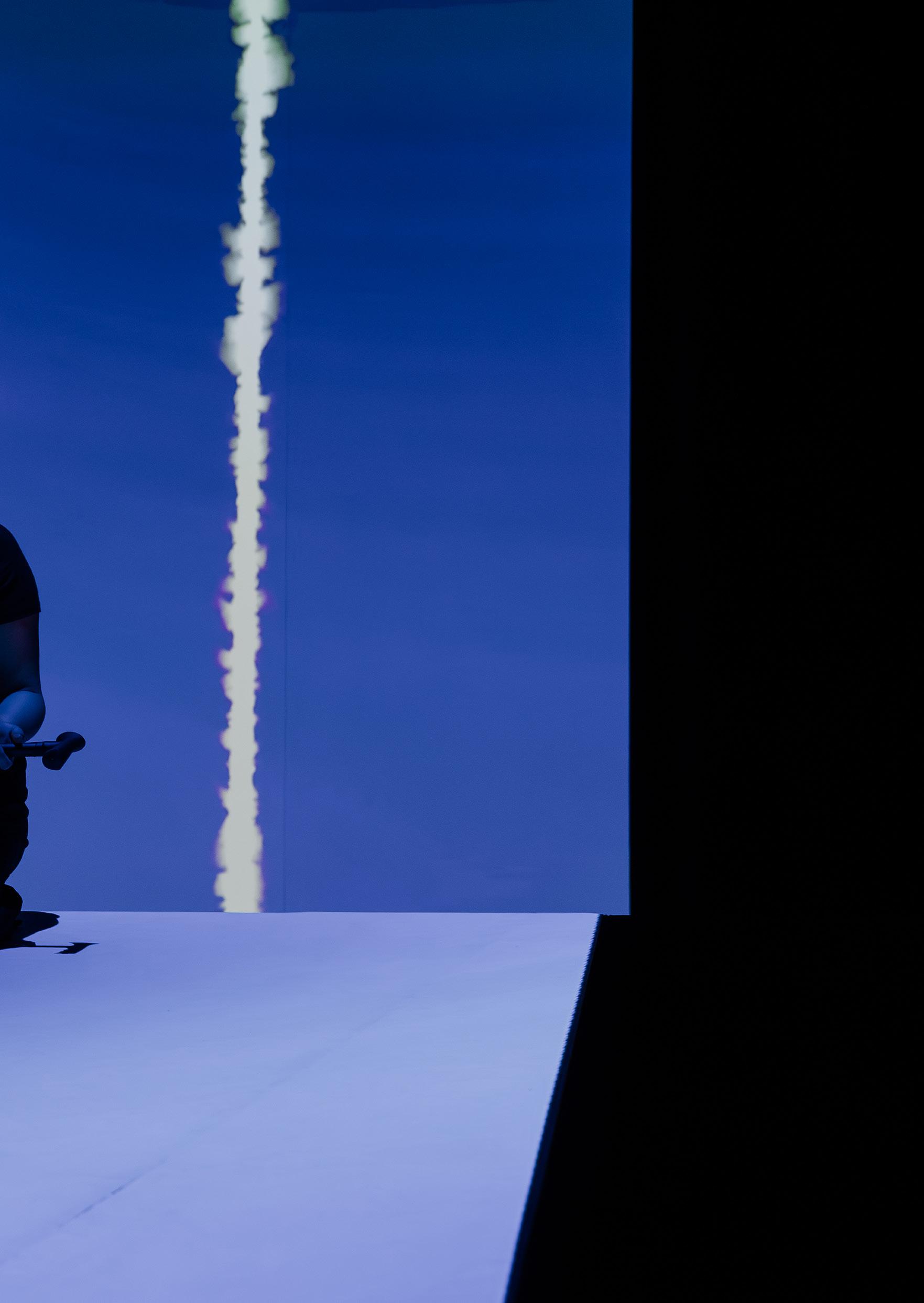
Rehearsal Diary
By Leroy Nurkka
MONDAY
This production of Tiri Te Araroa Woman Far Walking comes after a year of pre-production and three wānanga with director Katie Wolfe, actors Miriama McDowell and Nī Dekkers-Reihana, and playwright Witi Ihimaera. By the first day of rehearsal, the kaupapa is already deeply rooted.
The mihi whakatau brings together the full creative team. Each department — set, costume, lighting, sound, and AV — presents their design concepts. The collective vision feels operatic and resolute: a weaving of te reo Māori and te reo Pākehā, Māori and Western forms, joined on the shared ground of theatre. It is, as Wolfe says, “the earth beneath us, the sky above, and the air between.”
by Miriama and Nī, with the team stopping often to discuss rhythm, tone, and transitions. Wolfe encourages open conversation about why scenes exist and how Tiri’s story moves emotionally through time.
This is part dramaturgy, part translation. The group experiments with how te reo Māori and English interlock in performance. These sessions will form the basis of the working production script, remaining true to mātauranga Māori while signposting meaning for all audiences.
TUESDAY
Rehearsals begin in earnest with a complete table read. The current script — drawn from 25 years of versions — is read scene by scene
WEDNESDAY
The third day continues the slow unpacking of the text. Wolfe, McDowell, Dekkers-Reihana, and mātauranga Māori advisor Merepaea Dunn collaborate line by line, refining the pace and the emotional undercurrents of dialogue. Wolfe’s approach is patient and layered — treating rehearsal as discovery rather than instruction.
Discussions explore dialect and pronunciation, with special
care taken for Ngāti Porou kupu and idioms. The aim is balance: maintaining authenticity while ensuring comprehension for learners of te reo Māori. Non-verbal storytelling also becomes a focus — gestures, stillness, and gaze used to carry meaning where language pauses.
FRIDAY
THURSDAY
Physical work begins. Miriama brings in reference images for Tiri’s posture, centre of energy, and presence at different stages of her 185-year life. She experiments with pace, breath, and weight distribution — finding how an ancient body moves without mimicry.
The raked toki platform becomes a point of fascination. Even in mockup form, its steep incline forces a new vocabulary of movement — part bird, part insect. The actors spend time simply walking it, mapping balance, testing gravity.
Afternoon sessions return to Tiri’s opening sequence. The team debates the musicality of her language — how she shifts between te reo Māori and English, sometimes polished, sometimes broken. Wolfe notes that when Tiri retreats into English she is protecting herself; when she speaks in her reo rangatira, she exposes the wound.
The week ends with a mix of movement training and script refinement. Warm-ups emphasise breath and tinana awareness, essential for a production that demands full-body storytelling. Trust work between Miriama and Nī becomes central — discovering shared gravity, eye contact, and physical counterbalance.
Wolfe revisits the New Zealand Wars sequence, paring back historical exposition to focus on Tiri’s personal loss. A Ringatū hīmene adapted into waiata replaces text-heavy passages, carrying emotional and historical weight through song. The actors learn both melody and meaning, guided by Merepaea, allowing waiata and haka to communicate what words cannot.
By the week’s end, the company has built a foundation of trust and shared purpose. Wolfe’s leadership is evident in her restraint: a director who shapes by listening, allowing the river of collaboration to find its own course.
Leroy Nurkka is completing a Master of Arts in Creative Writing at the International Institute of Modern Letters, Victoria University of Wellington
Ngā Kaiwhakaari | Cast

Miriama McDowell
Tiri
Ko Motatau te maunga
Ko Taikirau te awa
Ko Ngātokimatawhaorua te waka
Ko Miria te marae
Ko Ngāti Hine me Ngāpuhi ngā iwi
Ko Kawiti te rangatira
Ko Hineamaru te tupuna
Ko Miriama McDowell ahau
Miriama McDowell has worked in the theatre and screen industry for over twenty years. She is an actor, director, writer and dramaturg. Miriama is a graduate of Toi Whakaari: NZ Drama School, a founding member of Intimacy Coordinators Aotearoa and a board member of Equity NZ. She is also the māmā of two girls, who have led her to advocate for better support for mothers in the theatre and screen industries.
Miriama’s work has spanned the big screen, the small screen and the theatre. She won a Best Actress Award at the NZ Film Awards in 2017 for her role in The Great Maiden’s Blush, and a 2020 NZ TV Awards Best Actress Award for her lead role in Head High Most recently, she played Younger Whina in feature film Whina.
For Miriama, working on screen is a great love of her life, but working in the theatre is coming home.
Miriama has worked with all the major theatre companies in Aotearoa, including Taki Rua, Massive Theatre Company, Te Pou Theatre, Silo Theatre, The Court Theatre, Tawata Productions and Auckland Theatre Company.
In 2015, Miriama went to Paris to study at Ecole Philippe Gaulier, which sealed her passion for Le Jeu – the game. This philosophy of bringing a playfulness to everything you do as an actor, has been a major influence in her life and work.
In 2023, Miriama took a year out to


Nī Dekkers-Reihana
Tilly
Ko Puhunga Tohorā te maunga
Ko Mangatawa rāua ko Otawa ngā awa
Ko Ngātokimatawhaorua te waka
Ko Pukerata te marae
Ko Ngaituteauru te hapū
Ko Ngāpuhi te iwi
Ko Nī Dekkers-Reihana ahau
Nī Dekkers-Reihana has worked in theatre for over 15 years and, in recent years, has expanded to screen. They have performed on main stages across Aotearoa, winning performance awards for The Haka Party Incident, Anahera, The Mooncake and the Kūmara, Pakaru, 4 Billion Likes! and more.
Nī is also a director in theatre. Having won Best Director in the NZ Fringe Festival in 2017, they recently reignited their directing mahi as a rehearsal director for the remount of The Haka Party Incident in 2023. This year, they participated in the Auckland Theatre Company’s The Engine Room Residency, assisting and learning from directors Jane Yonge and Shane Bosher. In 2024, they directed Sam Brooks’ Lads on the Island at Circa Theatre and recently they directed a sold-out season of Sean Rivera’s May Mga Uod Ang Utak Mo.
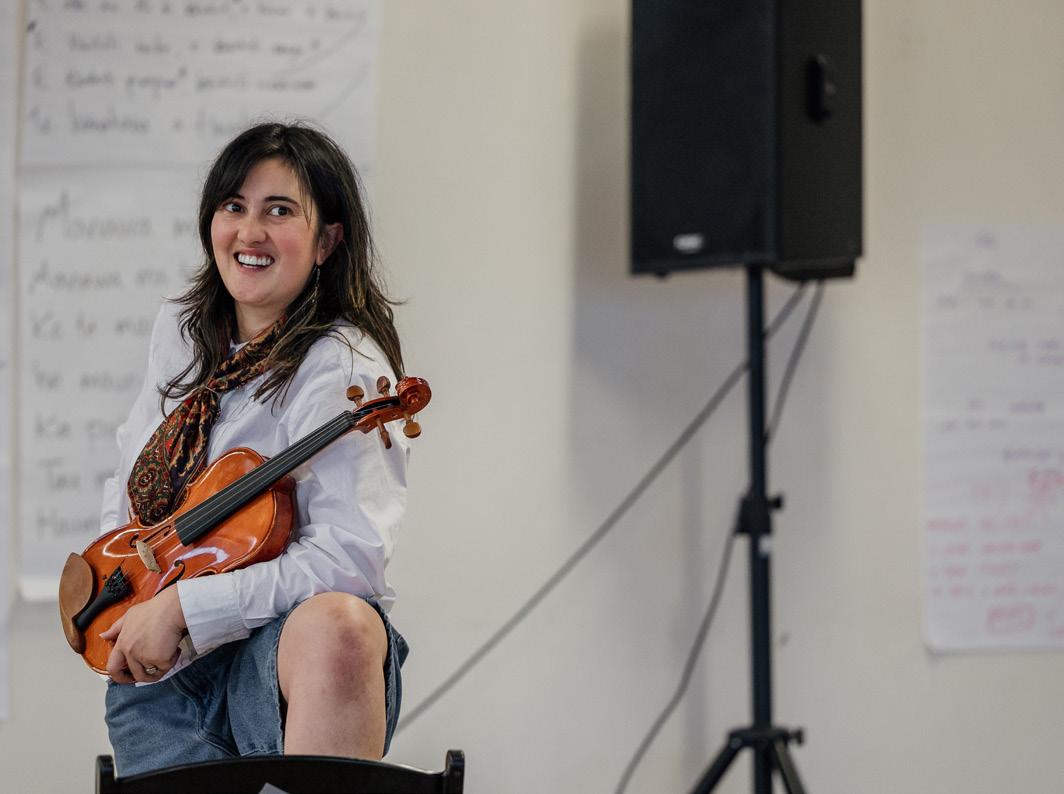
Interviews with the Cast
Miriama McDowell — Tiri
What is the most challenging thing about embodying Tiri, and the most rewarding?
“The biggest wero is the reo. I’m a reo learner and will always be learning that language. I can’t wait to get my tongue around all those beautiful words. The most rewarding part is the same — spending time with the words and being challenged to tell this story through them.”
What do you want audiences to feel walking away from this play?
“I really want rangatahi Māori to come to this play and see themselves reflected on stage — and to see these points in history that Witi has chosen to bring to life. I hope the whole audience, especially rangatahi, leaves wanting to learn more.”
As a wāhine Māori, how do you connect to Tiri to tell this story?
“Every time I read the script out loud, it hits me differently. But it’s always the parts where she talks about her children — what has happened to her children — that really affect me. Watching what’s happening to children in Gaza, too, and the violence they’re facing, I connect with that deeply through the script.”
How are you preparing for Tiri’s walking sticks and voice?
“She’s an anchor point to the amazing set that’s been designed. The tokatoka (walking sticks) help me ground myself because I’m quite still on stage. Having two of us means we’ve taken something real and turned it into something symbolic and theatrical.
When I played Whina Cooper, I learned that everyone talked about her voice — that grounded, commanding tone. I think Tiri’s the same. I’ve been observing kuia and how their voices can still cut through a room even when their bodies can’t.”
How does your costume affect the way you move as Tiri?
“I’m really excited about the beautiful kākahu that extends five or six metres behind me. I can already feel the weight of it — and how that weight will shape how Tiri moves and carries her memories. I’m interested in how to carry both the garment and her history.”

If the space between audience and performer is a kind of call and response, how do you think that will play out?
“I love breaking the fourth wall. When I worked at Pop-up Globe, performing fifty shows directly to the audience, I found it one of my favourite things.
Tiri literally tells the audience to go away and not come back — which is such a gift as an actor. You can play with how far to push that, how long to wait. In Māori theatre, the audience talks back, talks at you, talks about you — that relationship is always alive.”

Why do you think this story is important to share now, in 2025?
“It feels like such an important play for this moment in Aotearoa’s history, when our reo is being challenged politically. I joined the hīkoi to Parliament last year with my children — it was such a significant moment for us as a whānau, walking with so many others.
It feels like exactly the right time to look again at our history and ask, ‘Where are we now?’ It’s been over twenty years since this play was last staged, so part of the process was asking: what about now? What’s the next chapter?”
What moments in the story feel most significant for you?
“What I love about theatre is that it’s about process — it changes every night. The significant moment might shift depending on what’s happening between me and the audience. These are real stories, our history, so they hit differently each time.
My dad was involved in the Springbok Tour protests, so that part always lands differently for me because it connects directly to my own whakapapa.”
Nī Dekkers-Reihana — Tilly
How do your costumes affect the way you move and feel as Tilly?
“My base costume is really light and free — perfect for my character, because it lets me move easily. Tiri’s like a tree, and I’m more like a pīwakawaka, fluttering everywhere. The other parts of my costume are deliberately restrictive to show how clothing and movement change across time.”
How do you use the space between you and the audience?
“This show is a conversation with the audience. I’m there to help facilitate that between Tiri and them — but I end up in that conversation too. It’s not about breaking the fourth wall; it’s about inviting them into it.”
How do you approach performing in te reo Māori?
“Te reo Māori isn’t my first language, but it is my language. I’m putting in a lot of work — and a lot of trust in the process. I went to a bilingual school, Raglan Area School, so the foundation is there for me, thankfully. But it’s still a huge challenge. I’m used to learning lines in English — this time, it’s about rhythm, breath, and meaning as much as words.”

Online & in the Media
Auckland Theatre Company
Rehearsal Room videos:
IN REHEARSALS
Go behind the scenes as the cast and creative team bring Tiri Te Araroa Woman Far Walking to life — featuring Miriama McDowell, Nī Dekkers-Reihana, and director Katie Wolfe.
Tiri: Te Araroa Woman Far Walking | In Rehearsals

COSTUME DESIGN IN FOCUS
Costume Designer Te Ura TaripoHoskins brings together the past and present in Tiri Te Araroa Woman Far Walking, blending traditional Māori clothing with bold contemporary designs. From flax to fabric, her designs honour the kuia who have walked before us and the rangatahi who walk ahead.
Tiri: Te Araroa Woman Far Walking | Costume Design in Focus
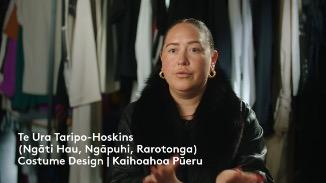
IN THE MEDIA
Tiri Te Araroa: The Resilience of Wāhine Māori | Capsule NZ
Witi Ihimaera’s play Woman Far Walking strides proudly into 2025 | The Spinoff
Miriama McDowell and Nī DekkersReihana talk wāhine Māori resilience, rangatahi strength, and language reclamation.
Marking its 25th anniversary, Witi Ihimaera’s landmark play returns as a new bilingual production — a fierce, hopeful reflection on Aotearoa’s past and future.
‘Kia ora koro’: Witi Ihimaera isn’t worried about te reo dying | The Post
Through the eyes of one who was there | The Post
Witi Ihimaera and Katie Wolfe reflect on their creative partnership and the power of Tiri Te Araroa Woman Far Walking to bridge te reo Māori and English on today’s stage.
A preview of Auckland Theatre Company’s new bilingual staging of Witi Ihimaera’s Tiri Te Araroa Woman Far Walking, a story of history, language, and resilience.
Activities
This section is specifically designed to help you unpack the show and utilise the information in this pack in the classroom with your kaiako/ teacher. Each section references information in the pack and is structured in the following way:
• Pre-reading/Unpacking: A literacy based activity to analyse the material in this pack
• In the Classroom: Brainstorming, prompt and practical activities to provoke discussion and help you explore the education material provided
• Theatre Aotearoa: Activities to help you explore how a text by an Aotearoa playwright heals, educates, entertains and transforms an audience. This
section can be used to help inform internal assessments 91940: Explore the function of Theatre Aotearoa or if you are studying the New Zealand Theatre Form internally or externally at Levels Two and Three. You might also use this section to inform learning around a significant playwright at Levels Two and Three.
Revise: Questions for you to complete individually in preparation for your AS91943 Portfolio to be submitted in October or AS91219 or AS91518 Exam in November. These questions have been specifically developed from the 2026 Exam Specifications provided via this link: UPDATED LINK FOR 2026 (Sam to provide)
The whakapapa of Tiri Te Araroa Woman Far Walking
For this section of the education pack you will need to reference pages15 and 17.
Witi Ihimaera has reawakened his characters a number of times over the years to respond to historical, political and social events. Katie Wolfe and Maioha Allen have worked with Ihimaera to explore this evocative narrative in our current context, asking the audience to engage with these women walking and the themes, ideas and questions being represented and asked in the stage space.
PRE-READING AND LISTENING: Use this information to inform the “In The Classroom“ activities.
• "Referencing the Online and in the Media section of this pack [page 55] divide into four groups. Each groups chooses one of the media articles to focus on. Brainstorm the important ideas that jump out to your group."
• In small groups read About The Play and Historical Context
• Highlight ideas that interest you
• Circle quotes you think would enrich an answer in an exam
• Underline and annotate ideas that link to a specific moment in the performance.
IN THE CLASSROOM:
(Divide into four groups to complete the following)
BRAINSTORM - What is in a name? Have a class discussion about the original title Woman Far Walking and the updated title Tiri Te Araroa Woman Far Walking. You will want to think about:
• Why do you think Ihimaera gave this play the title Woman Far Walking. What imagery does this evoke for you as an audience member?
• Why do you think the title has been added too? How does it represent / embody this version of the play?
• How are both titles explicitly linked to / symbolise Aotearoa New Zealand?
• Identify a performance moment that is explicitly linked to the title of the play.
Extend: Extend on the above brainstorm by responding to the following statement: “Tiri is ready to be reawakened, this time with a lot to say because she’s still holding a lot of grief. However, she continues to walk regardless and will ask the audience several questions to evoke the thought of how we are going to walk alongside each other into the future.”
CONSIDER:
• What grief do you think Tiri is holding? What questions is this interpretation asking you as an audience member?
• What do you think Wolfe’s purpose for adapting this play is and what was driving her passion to bring it to the stage in 2025 with Auckland Theatre Company?
• What did you think about at the time and what have you thought about since?
• Any links to what you might have been learning in English if you are studying New Zealand literature.
EXPLORE - The impact of Te Tiriti o Waitangi on the narrative.
Discuss with your kaiako/teacher how Te Tiriti o Waitangi is woven through Tiri Te Araroa Woman Far Walking, you might want to focus on the following in your discussion:
• How Witi Ihimaera was influenced by the history surrounding the signing in the writing of the original play
• How Wolfe and Allen might have been influenced by the current status of Te Tiriti in their adaptation
• Why is it important to read, see and understand Te Tiriti o Waitangi’s impact within creative work?
Extend your discussion by reflecting on the following excerpt:
“In the play, Tiri knows the importance of sharing her hard truths and Tilly often reminds Tiri to ignite this sharing. This perpetuates generosity of knowledge and care and is a demonstration of the well known whakataukī: ka mua, ka muri (walking backwards into the future).”
Your reflection could be:
• A recorded voice note of a small group discussion
• A short individual essay
• A performance that explores the excerpt
• A series of sketches and annotations
REVISE - (COMPLETE THESE AS YOU STUDY FOR YOUR EXAM)
Drama Elements and how they draw our attention to themes, motifs and symbols:
• What were the main themes, questions and ideas evident in the performance? Link these themes, questions and ideas to specific moments or examples from the performance.
• Identify recurring symbols or motifs throughout the performance. Explain why they were important in helping you understand ideas being communicated in Tiri Te Araroa Woman Far Walking.
• How do these themes, symbols or ideas link to the wider world of the play and what impact does this have on the audience?
• Were there moments where the content was confronting or forced you to think about something in a new light? What impact does this have on the audience and you as a member of the audience?
• Reference the wider reading and historical context in this pack, as well as research material you have brainstormed and think about the impact these themes, symbols or ideas have on the lives and arcs of the characters in the play.
DRAMA CONVENTIONS
STRATEGIES ESTABLISHED TO MAKE MEANING AND CONNECT TO WIDER CONTEXT:
(NB - make sure you are familiar with what the established Drama Conventions are by discussing this with your teacher)
• Identify a moment in the performance where Drama Conventions were used to create focus, mood or atmosphere:
• Explain how the convention or combination of conventions were used in the performance
• Discuss the impact of the use of the convention or combination of conventions in this moment
• Discuss how meaning was created for you, as an audience member, in this moment
• Discuss how the use of a convention or combination of conventions in a specific moment helped you think about the big ideas and themes of the play.
• What was the wider context (socially, historically, politically or geographically) that this moment linked to?
Katie Wolfe's Vision & Ihimaera’s Story in 2025
PRE-READING AND LISTENING:
Use this information to inform the “In The Classroom“ activities.
• As a class listen to watch [insert link] and brainstorm the important ideas
• In small groups read the Directors Vision
• Highlight ideas that interest you
• Circle quotes you think would enrich an answer in an exam
• Underline and annotate ideas that link to a specific moment in the performance.
• If you recorded the post show forum, find excerpts where Katie Wolfe answered questions:
• Write down ideas that interest you
• Record quotes you think would enrich an answer in a your report or exam
• Record moments in the forum that surprised you or provided more context for something you saw on stage
IN THE CLASSROOM:
(Divide into four groups to complete the following)
BRAINSTORM - Conduct an initial brainstorm around why you think Katie Wolfe felt so strongly about telling this particular story. Think about how she worked with Witi Ihimaera, the way she has realised her vision within the script and on the stage? Use the information that you have collated from the pre-reading and listening activity to inform your brainstorm.
DISCUSS AND EXTEND - Each group takes one of the prompts below to discuss what you think Wolfe intended to communicate through her directing choices. You could also refer to anything you discussed in the previous activities as well, building on this whākaaro.
Prompts: Access to the original script may be helpful to support discussion.
• Use of Te Reo Māori: discuss the use of te reo Māori and how it has been utilised in this rendition of the play. If you have access to an original script, you may want to think about how the incorporation of te reo has impacted the narrative.
• The narrative: discuss how Wolfe has ordered the narrative, what threads are highlighted and how did this impact the way you understood the story being told?
• The big themes and intentions: identify the themes or intentions that Wolfe had for the piece or chose to highlight through design or directorial choices. Whose stories were being told and why was this important?
• Style and flair: can you identify a specific style or aesthetic in the way the performance was pulled together. What do you think Wofle intended to communicate through these choices?
You will have 10 minutes to discuss and annotate around the prompt you are given as a group. Then you will rotate around the different prompts, spending 5 minutes at each, discussing and adding your own ideas. Once you are back at your original brainstorm prompt collate the ideas into bullet points
and share these back to the class for discussion. Make sure you take photos of all the evidence you produce during this activity to reference during your revision later in the year.
PHYSICALISE - Abstracting
Ideas and finding meaning
Bring your the ideas from your brainstorms and discussions into a stylistic devised scene:
• Create a scene influenced in style by Tiri Te Araroa Woman Far Walking
• Identify conventions that were used within the performance and reinterpret them in your own way
• Commit to a style of narrative that suits the message you are trying to capture or communicate; circular, episodic, linear
• Perform for your peers, for feedback
• If time, implement the feedback to elevate your scene
• Focus questions: how did the scenes affect you more as an audience member and why? What enabled you to find meaning within the scene and why? Was the idea that the scene was created around clear? How did it impact you? How did it connect to your own world socially and politically?
REVISE - (COMPLETE THESE AS YOU STUDY FOR YOUR EXAM)
• Discuss the purpose of the performance and how the themes or ideas link to what is happening in the world; socially, politically or historically. Link your ideas to specific moments or examples from the performance.
• How did the way the performance was realised impact the style of delivery of the narrative/story?
• How does the content of the play challenge and serve the audience?
• Discuss how the director brought the story to life using Drama Components - Elements, Conventions, Techniques and Technologies.
• What do you think Katie Wolfe is asking you to think about in the way she has directed Tiri Te Araroa Woman Far Walking
• How did the acting and staging choices affect you as an audience member?
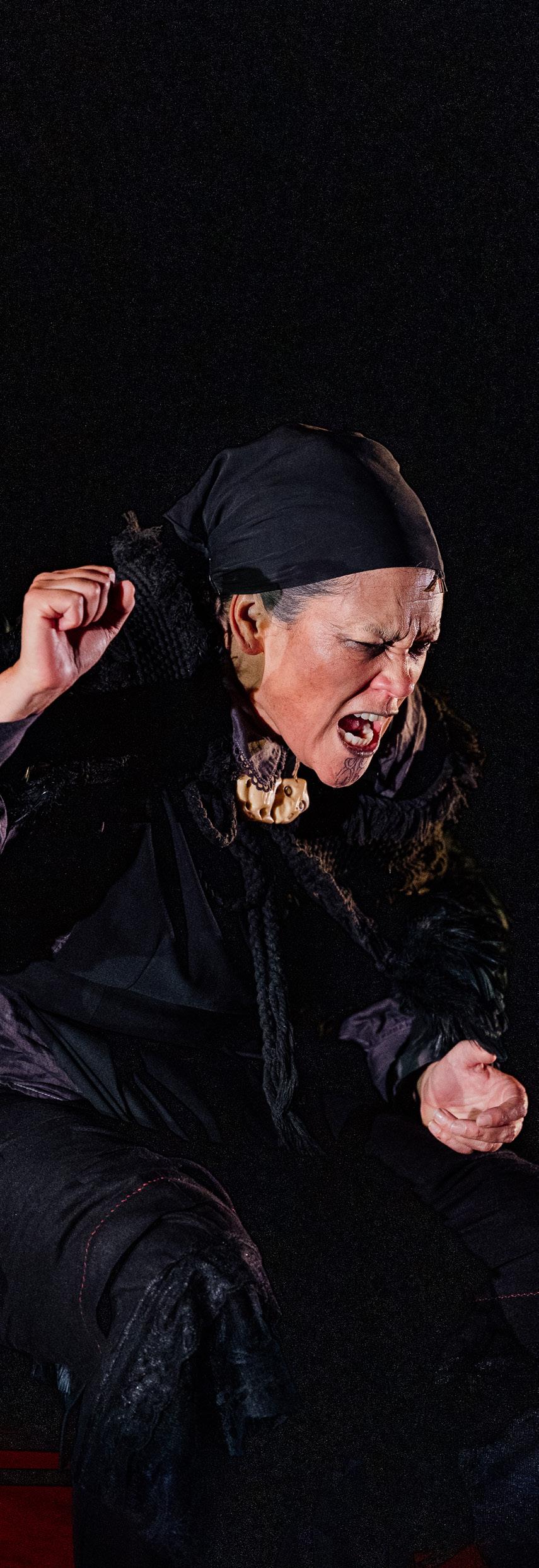
Tiri and Tilly: Exploring the Characters
When you are thinking about an actor's performance to write about in an exam or report setting you will want to build a comprehensive profile of how they used their body, voice, movement and use of space. Details about motivation, ideas or symbols they highlighted and moments of subtext that pointed to themes or relationship dynamics. You will want to link these details to specific moments in the performance, describing what was happening on stage and linking to big ideas and wider context.
These activities will enable you to build a kētē of information about characters you found compelling or who were integral to the narrative: Ihimaera comments that “Tiri has managed to walk from the East Coast from small audiences of whānau, iwi around the mōtū of Aotearoa. Now here she is. She’s reached the pinnacle of her representational glory on the main stage of Auckland.” Use these activities to explore the purpose and point of view of these wāhine toa within the narrative of Tiri Te Araroa Woman Far Walking.
PRE-READING
• In small groups read the Cast Interviews (and the video's linked in the Online and in the Media, page 54), these also include an interview with Witi Ihimaera:
• Highlight ideas that interest you
• Circle quotes you think would enrich an answer in an exam
• Underline and annotate ideas that link to a specific moment in the performance.
• If you recorded the post show forum, find excerpts where the actors answered questions:
• Write down ideas that interest you
• Record quotes you think would enrich an answer in your exam
• Record moments in the forum that surprised you or provided more context for something you saw on stage.
IN THE CLASSROOM
Tiri Te Araroa Woman Far Walking is a powerful example of exploring Aotearoa New Zealand’s history through grounded and provocative storytelling. Using the information from the ‘Cast Interviews’ section of this pack, including the photographs complete the following activity:
• Map the historical events and characters Tiri evokes throughout the narrative. You will want to add dialogue from the performance
• If your kaiako/teacher is a member of Whakaari Aotearoa Drama New Zealand this resource might be helpful in creating your timeline: www.drama.org.nz/ resources/aotearoa-timelines
• Outline the key moments where Tiri shuts down, annotate why and include notes about her use of drama techniques in these moments
• Annotate what the characters think of each other, include how the characters contrast, the tensions of the relationships
• Discuss the impact of the incorporation of Te Reo Māori
• Add key quotes for each character
• Come up with a key sentence which captures each character's purpose in the story being told.
Reflection question: As you constructed the timeline, did you find out new information or come up with interesting new ideas to explore? Discuss this as a class with your teacher.
EXPLORING CHARACTER THROUGH MOVEMENT
- divide into three groups. Assign Tilly, Tiri and Witi Ihimaera to each of the groups.
For Tilly and Tiri: Create a techniques profile for the character based on the following:
• How did they use their body techniques to express their character?
• How did they use their voice techniques to express their character?
• How did they move through the space and how did they support their characterisation?
• How was their characterisation influenced by the historical events represented within the narrative?
• How Te Ao Māori and mātauranga Māori influenced the actors use of techniques to deliver the narrative.
For Witi Ihimaera: explore his realisation of Tilly and Tiri in a large mind map with distinct headings (remember all these notes should be from your point of view, with reference to the cast and Ihimaera’s interviews):
• Ihi, wehi and wana: what are the most significant moments for Ihimaera that reach out to the audience to touch them?
• The wairua of the performance; how the characterisation of Tiri and Tilly embody the spirit of the play
• The key messages Ihimaera wants you to understand about Tiri and Tilly through the performance
• The impact of a larger incorporation of te reo Māori in Auckland Theatre Company’s version of the play.
Share your notes back with each other and pin them up on the wall or board to support your exploration in the next activity.
PHYSICALISE - using the notes you have compiled in your techniques profile recreate a climactic moment of the play for. Explore the characters' thoughts and ideas in this moment, as well as responding to Ihimaera’s whakaaro. You will:
• Extend on the moment, using characters from the play AND/OR adding other characters
• Use slow motion movement, specific posture, flocking AND/OR chorus of movement
• Spoken thought to reflect all the thoughts and feelings of the character
• Use soundscape that is evocative of Aotearoa New Zealand and evoke mood, tension and atmosphere
• Make the scene creative and fun
• Perform for each other; gain feedback
Reflect: How does bringing characters to life in the classroom and exploring their physicality and motivations through performance help deepen your understanding of Tiri Te Araroa Woman Far Walking.
REVISE
DRAMA TECHNIQUES: BODY, VOICE, MOVEMENT AND SPACE:
• Describe how an actor who you found interesting or compelling used drama techniques in a specific moment in the performance.
• Describe how two actors used proximity during a moment of tension.
• Discuss how an actor uses drama techniques during a solo moment on stage. What were they aiming to communicate? What did you understand at that moment?
• Explain another actor’s use of drama techniques and how they created a sense of authenticity within the performance.
• Choose specific moments where you felt the actor used their body, voice, movement, and space in combination to create impact, focus, or to support an important idea.
• Discuss why you think authenticity is important in a contemporary performance
• Thinking about the actors and the way they created their characters:
• How did they use techniques to create a sense of time and place?
• How did they use techniques to communicate their history?
• How did an actor use drama techniques to communicate subtext in their performance? Use a specific moment and example to discuss this use of subtext.
• Discuss what you found compelling about an actor’s use of drama techniques in the performance. Choose a specific moment to focus on.
CHARACTER:
• Discuss what the character communicated to the audience; how did the actor portray them? Plot their character arc and describe how he uses techniques to communicate this.
• Discuss the purpose of the characters:
• What impact do they have on the narrative, as well as the audience and actors' relationship?
• How does the actor's use of techniques communicate their purpose in the performance?
• Explore the ensemble of characters as a whole: what purpose do they serve in the narrative?
Exploring the design of Tiri Te Araroa Woman Far Walking
When we are thinking about the design or technological elements of a show, we need to explore how this supports the story being told, heightens atmosphere and tension or creates mood. Tiri Te Araroa Woman Far Walking reawakens a beautiful and impactful Aotearoa New Zealand play weaving for the 2025 audience. The design and set play an integral part in communicating
the narrative and holding space for Tiri, Tilly and the audience to walk together through our history. Katie Wolfe has drawn together a team of designers who she has worked in step with on powerful works such as The Haka Party Incident to realise a evocative and coherent vision. This section will support you to explore the design choices made and what they communicate to the audience.
PRE-READING
Using the design interviews, complete the chart below to collate important information from the pack.
E.G. costume
E.G. Lighting
IN THE CLASSROOM
Sketch and annotate the set - Either individually or in small groups sketch the set on a large piece of craft paper OR print out an image from the Education Pack on a large piece of paper with space around the outside. Annotate in detail, referencing the following:
• Colour palette, material, shape
• The influence of te ao Māori on the set design
• Symbols, motifs or ideas that are highlighted by the set
• How certain characters are highlighted within the set space using other technologies; such as sound, lighting, props, costume
• Proximity to the audience and how this impacted the delivery style of the narrative
• Include quotes or information from the education pack, especially what the Director or Designer were hoping to achieve
COSTUME AND CHARACTER
- Te Ura Hoskins has approached costume design in a way that is influenced by te ao Māori and allows flexibility in storytelling for both Tiri and Tilly as they walk together through our countries history. Use this activity to unpack the costumes function and connection to character:
• In pairs or small groups choose one of the characters to focus on. Sketch and annotate their costume, ensure that you:
• Break down the pieces of the costume, sketching both the full look and the individual pieces
• Annotate explicit details fabric, patterns, colour, accessories
• the symbolic nature of the costume pieces and how they explicitly connect to the character wearing them - include quotes from the performance, actor and/or designer
• Discuss how the costume was multi-functional and describe a moment where it was used to represent another character
• Highlight and discuss the influence of te ao Māori and mātauranga Māori in the design.
• Save your sketches in your portfolio, on the classroom wall or scan into a digital version.
LIGHTING AND TIRI
- Jane Hakaraia has identified four key lighting states: The Trees, First Base Neutral State, Second Base Neutral State and Shadows & Silhouetting. Explore how these lighting states impact the delivery of the narrative and realisation of character through the following activity:
• As a class brainstorm what the four lighting states represented on stage, how they were tied to character and supported the narrative being told.
• Split into four groups, assigning a state to each group. Choose a key moment for each of the lighting states and sketch it in detail:
• Annotate how lighting supported character and story in this moment
• How did it evoke mood, tension, contrast AND/OR atmosphere
• Add quotes or dialogue from the production
• Individually for homework, respond to the following questions;
• How does lighting enhance the performance of Tiri Te Araroa Woman Far Walking?
• How did the use of the four specific lighting states deepen your understanding of the ideas being expressed in a key moment on stage?
SOUND/AV - Along with evocative staging, contrasting lighting and multi-functional costumes that weave tradition and symbolism, the sound and audio-visual design work in conjunction to represent a sense of time, place and history. Evoking Aotearoa New Zealand and nestling the audience in Tiri’s memory. Use
this activity to discuss the how the sound and audiovisual design was used in a symbolic way:
• Construct a visual timeline of the plays events, you could do this on a long piece of craft paper rolled along the classroom floor or on the white board
• Annotate along the timeline where sound and audio visual elements were used, describe in detail what you were hearing and seeing in that moment
• Identify where specific Māori instruments were used, research these instruments and explain what they evoke; how did you feel, what did you think at the time and since?
• Highlight where sounds/visuals explicitly evoked Aotearoa New Zealand
• Highlight moments where the use of sound and audio visuals was linked to movement and character expression; emotions, moments of storytelling, etc
INDIVIDUAL ACTIVITY: using the information you have collected in the activity above, respond to the following prompt for homework:
Discuss how the sound and audio visual design expressed Tiri’s memory of events and how did this impact or support your understanding of the story being told?
REVISE - (COMPLETE THESE AS YOU STUDY FOR YOUR EXAM)
• Discuss how technology or design was used during a climatic moment in the performance? What do you think was at stake within the scene?
• What was the impact of the way the design, directorial, and acting choices worked together? Choose a moment that surprised, shocked, or excited you to talk about.
• Discuss why the use of sound and lighting design was integral to this performance? Focus on the mood created by sound choices, use of colour and the shapes created by the angles or composition of lighting.
• How were design and directorial elements (props, setting, AV, costuming, audience positioning and interaction) and the Drama Elements used to build the performance? How did this make you feel as a member of the audience?
• How was technology used to highlight important ideas, themes and symbols in the performance?
• How was contrast and/or focus created or built through technology and why was this important?
• How did the use of technology help you gain a deeper understanding of the themes of Tiri; Te Araroa Woman Far Walking?
• How did technology highlight the different characters' motivations expressed within the performance?
• Discuss why this was impactful, exciting or challenged your expectations.
• How were costumes used to communicate the characters' purpose in the performance?
IMPORTANT NOTE: When you are writing about Set or Costume, you need to be specific about the following details and also sketch what you see. Imagine the person you are writing for has not seen the production and create a vivid image in their mind of what you saw:
• For example: Set/Props
TECHNOLOGY: link your ideas to specific moments or examples in the performance. Think about lighting, set, sound, props, costumes, makeup and how this helped bring you into the world of the play.
• How was technology used to create the atmosphere in the performance?
• The size, shape and dimensions of any set pieces or props used
• The materials used, their textures and the colours
Preparing for Theatre Aotearoa - Theatre’s ability to heal, educate, entertain and transform
Titiro whakamuri, kōkiri whakamua –
Drama is influenced by whakapapa and is a way to respond to and share identity, culture, and perspectives
If you are a Year 10 student viewing Tiri Te Araroa Woman Far Walking this year, this section of the pack will help you to unpack and explore the play and apply that learning to an internal achievement standard in 2026. For Year 11 - 13 students this section of the pack aims to extend your understanding of theatre and its function. It will also prompt you to think about how what you see at the theatre can connect with work you are doing in class.
An aspect of the significant learning done at Level One of NCEA is to “contribute to theatre Aotearoa and understand that drama is a way to explore and reflect on whakapapa.” You may be doing this through exploring plays written by Aotearoa playwrights in class, performing scenes from those plays, discussing the function of each play and how they connect with an audience.
THINKING ABOUT TIRI TE ARAROA
WOMAN FAR WALKING FOR AN AOTEAROA NEW ZEALAND CAST AND AUDIENCE:
ACTIVITY: As a class brainstorm all the ways that the performance was firmly rooted in Aotearoa and spoke to a local audience. Include the following examples in your brainstorm:
• Language or quotes that feel specific to Aotearoa
• Te Ao Māori/mātauranga Māori (Māori knowledge) elements or references
• Accents, acting style
• Specific design choices that reflected our place in the world
• Key scenes or viewpoints represented that reflected Aotearoa
Take a photo of this brainstorm and keep it in a shared digital space so you can reference it throughout the other activities in this pack.
Function in this section refers to: the plays ability to heal, educate, entertain or transform an audience.
In small groups or in pairs, brainstorm, research and record responses to the following questions. (A mode of recording has been suggested for each question in order to enrich your literacy skills):
THE FUNCTION OF TIRI TE ARAROA WOMAN FAR WALKING:
Brainstorm with pen and paper. Ensure you explore and debate the four words encompassed in the definition of function and then construct a written response that focuses on a specific scene.
• What ideas, themes or messages are being communicated to the audience?
• What impact is that having on the audience?
• How are these ideas healing, educating, entertaining or transforming the audience?
• Can you connect this to a specific scene or moment from the performance?
CONNECTION WITH THE AUDIENCE:
Record a verbal discussion where you talk about the following questions. You could brainstorm the questions first, but it is important you don’t script your response.
• Who do you think the intended audience is and why? Who do you think Ihimaera wrote this for and why? Why did Wolfe and Allen adapt the original text for a 2025 audience?
• What influence has Wolfe had on this rendition of the play? How do you think this connects with the audience?
• How has mātauranga Māori been woven through the performance? What impact does this have on the connection the audience has with the story being told?
• What draws you into the story? The actors, the design, the writing, the themes and ideas? Discuss why.
• What were you feeling throughout the performance?
• What have you thought about since?
You could use the following resource to support you: Purpose and Audience Analysis
COMMUNICATING FUNCTION THROUGH DRAMA TECHNIQUES:
these activities are based around developing the skill of sketching and annotation. You can cover one, some or all of the activities.
• Characters connection to the Tiri Te Araroa Woman Far Walking: Look at the characters or viewpoints of people represented in the scenes and explore their connection to the thematic content of the performance. Use these questions and the information in the front of this pack to guide you. Create a diagram that represents each character's stance or viewpoint, and explore why this is important
when discussing this [theme, issue, connect to specific play]. You could choose a couple of scenes to focus on.
• What do you know about the characters or what do the viewpoints outlined say about the people represented in the scenes - ethnicity, where they are from, their whānau, their upbringing - how does this influence the way they view climate change?
• What are their dreams and aspirations?
• What is motivating or driving them? Why do you think they behave the way they do around the core issues of the play?
• What are key quotes that capture the personality, beliefs and aspirations of the characters? How does this impact how they view [core issue of play]?
• What are their relationships like and what does this say about the way they act on the issues and themes evident in the play?
• Role on the Wall: Choose a character or viewpoint you found compelling or impactful. In a Role on the Wall explore how the actor used techniques to support the function of the play. Narrow this down to a single moment.
Role on the Wall instructions:
• Draw the outline of your character - could be a gingerbread man shape, stick figure, etc.
• On the outside you will note the external drama techniques you see the actor using in a specific moment, that communicate the function. Use of body, voice, movement and space
• On the inside you will think about or imagine what might be driving these choices; emotions, motivations, subtext.
• Mindmapping: Looking at the drama elements, choose one that you felt was highlighted in a moment in the performance that communicated the function. Create an extensive mind map which details how that element was brought to life through the script, the characters, directorial and design choices.
• For example; what does setting the performance in Aotearoa New Zealand communicate to the audience?
• For example; how is mātauranga Māori explicitly
woven into this performance of the play and what impact does it have on the audience? How does this support the communication of the core messages of the play?
• Storyboarding: Choose a moment where a specific drama convention highlights the function. Map out on a short storyboard with captions, how the convention was used, detailing what you saw on stage and what it communicated to the audience.
• Sketching and annotating: Choose a moment where technology was used to highlight the function. Sketch how this looked on stage and annotate comprehensively.
BRINGING IDEAS TO LIFE THROUGH PLAY: these ideas could contribute towards or become provocations/ stimulus for devised drama.
• Choose a line from Tiri Te Araroa Woman Far Walking that you found compelling or impactful. Discuss why as a group.
• Break down the line, think about what it means and what it represents in the play, how it might heal, educate, entertain or transform. What does it make you think about and feel? Does it call you to action?
• Develop a short scene that explores what you have discussed using conventions and elements.
• Prior to performance explain how your short scene connects to the line you have chosen and how it heals, educates, entertains or transforms.
• Make sure that you choose conventions and elements that will communicate your ideas in a coherent way.
• Choose a moment in the performance where you could add more information about a character or an event. This could be prior to the play beginning, during the narrative or what happened next.
• Develop a short scene using conventions and elements
• Discuss together how this scene extends on ideas in the play
• Prior to performance explain how your short scene heals, educates, entertains or transforms the audience. Discuss how you have used conventions and elements to communicate this.
• Block and rehearse the scene for an audience
• As you rehearse make choices about your techniques as an actor that will communicate the function of the scene to your audience
• Think about how elements can be enhanced and what conventions could be used in the blocking
• If you could use technology, what would it be? If you have access to it, have a play. If you don’t then express a few ideas to the audience prior to performing
• Perform your scene for your peers and gain feedback
• Justify your choices to the audience and explain what you intended to communicate
• Discuss whether your intention for the performance was communicated and understood. Gain feedback and advice
• If you have time you could implement any feedback given, to enhance how you communicated the function
PERFORM A SCENE: (If you have access to the full script from the play, perhaps Iheimaera’s original text)
• Choose a scene that you felt highlighted the function of the play
REFERENCES
Drama | NCEA
Explore the function of theatre
Aotearoa | NCEA
Tiri Te Araroa Woman Far Walking and Level One NCEA
“Drama transforms the tangible into the intangible.”
This section of the education pack is designed to support Level One drama students navigate the new Level One external Achievement Standard 91943 - Respond to a drama performance. Unlike the Level Two and Three external standards, which are an exam, you will be constructing a portfolio over a period of time in class. It will be based around three key aspects:
• key message of the performance, the use of drama components and your own personal response about how you connected to the performance, capturing the wairua (spirit) of what you watched.
This portfolio will be presented as a slideshow or PowerPoint and can be a mixture of written and audio visual material - the main question you should ask yourself as a student
is; how do I communicate my ideas, thoughts, and feelings about what I saw, the best? With that in mind, you are encouraged to collect your thoughts, discussions and do your research in a range of formats. Such as; voice notes, sketches and annotations, brainstorms, moodboards, recorded physical responses and writing.
Kaiako and ākonga please ensure you read this year's assessment specifications carefully as you prepare to submit this assessment. You can access the specifications via this link: NZQA Assessment Specifications - Level One
Below are three activities to support you to expand your ideas and support you during the teaching and learning phase of unpacking the performance.
KEY MESSAGE:
In pairs, small groups or as a whole class, discuss and brainstorm the following prompts:
• What do you think the playwright was trying to say? Why this story? Why these characters? Why this period of time?
• What do you think the director was trying to communicate through the choices they made? How does this connect with what the playwright has written?
• What do the characters in the performance represent and what do they communicate to the audience?
• What do you think the designers are trying to communicate through their choices? How does this bring the playwright's ideas to life?
Once you have brainstormed around these questions, you could journal, voice note or record thoughts around the following questions:
• How do you identify the key message of a performance?
• Can there be multiple key messages?
• Think about your interpretation of the performance - what was the key message to you?
• What physical evidence from the
performance connects to the key message? This could be a scene, a moment between characters, dialogue, a moment where the use of technology highlighted an idea.
• Describe these examples and sketch them in specific detail.
USE OF DRAMA COMPONENTS:
Drama components are techniques, elements, conventions and technologies. Make sure you have explored this language and terminology with your kaiako/ teacher.
Now that you have fleshed out what the key message might be, you need to connect it with the choices that the director, designer and actors have made and how they have used the drama components in combination.
Brainstorm in small groups, or in pairs:
• How an actor used drama techniques in a moment that communicated the key message
• How elements created a sense of mood, atmosphere or tension
• How conventions were used throughout the performance
• How technology enhanced the story being told
WAIRUA OF PERFORMANCE AND PERSONAL RESPONSE:
In the unpacking on the NCEA website for this standard, this aspect of the assessment is unpacked in detail. Your teacher will support you in understanding this and guide you to explore, research and develop your ideas.
Auckland Theatre Company have included an interview from Witi Ihimaera in this pack on page [X] which explicitly delves into ihi, wehi, wana and wairua of performance. You will want to reference this in your portfolio construction.
“The wairua of the performance is experienced as the intangible energetic and emotive qualities that carry the spirit and intention of the play. How the wairua is expressed by the performers provokes a response from the audience and allows them to reflect on the ideas and themes of the play based on their own life experiences and perspectives.”
- 1.4 - Unpacking
• What thoughts, ideas and feelings did the performers provoke in you?
• What have you reflected upon since watching the performance?
• What have you been thinking about (head) and feeling (heart) since?
• What did your gut/sense of intuition communicate to you as you watched the performance?
• What life experiences or perspectives do you bring? What connections did you make?
REFERENCES
Drama | NCEA
Level One External Specifications
